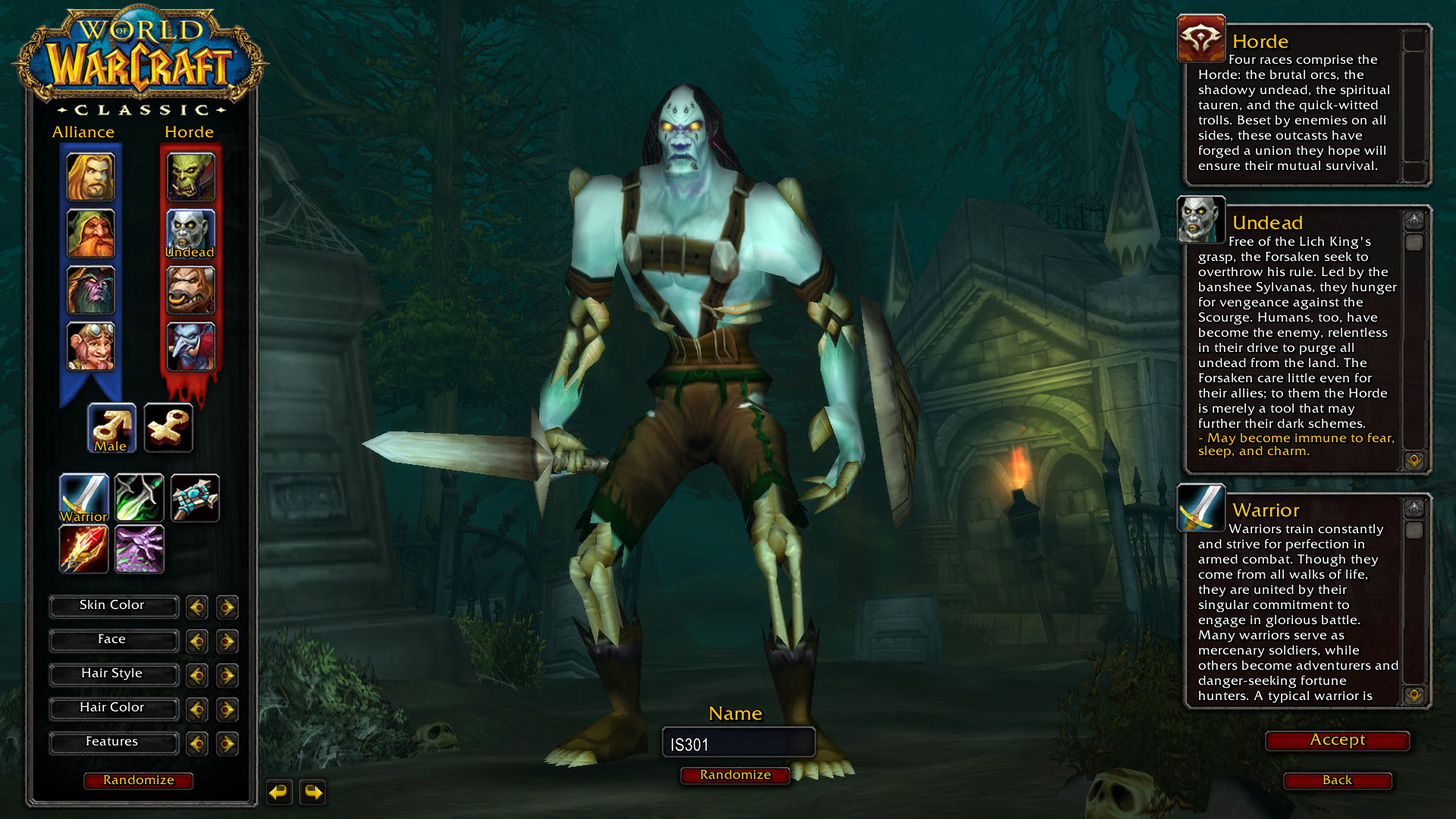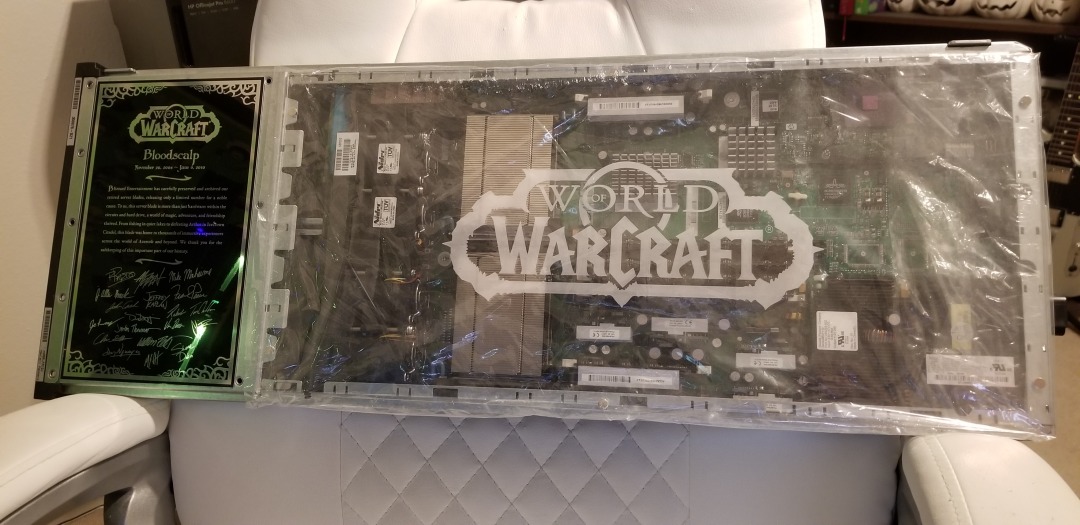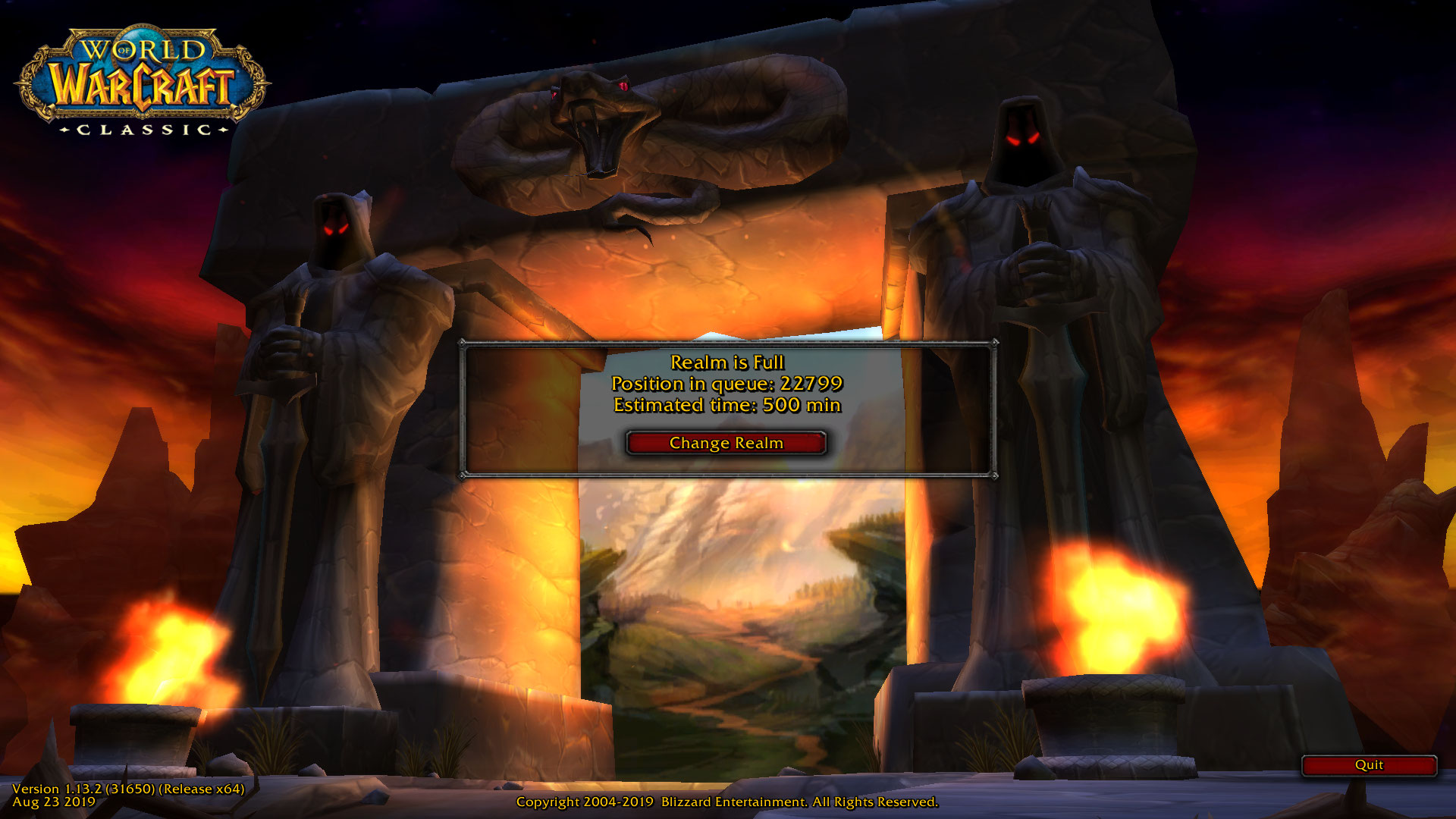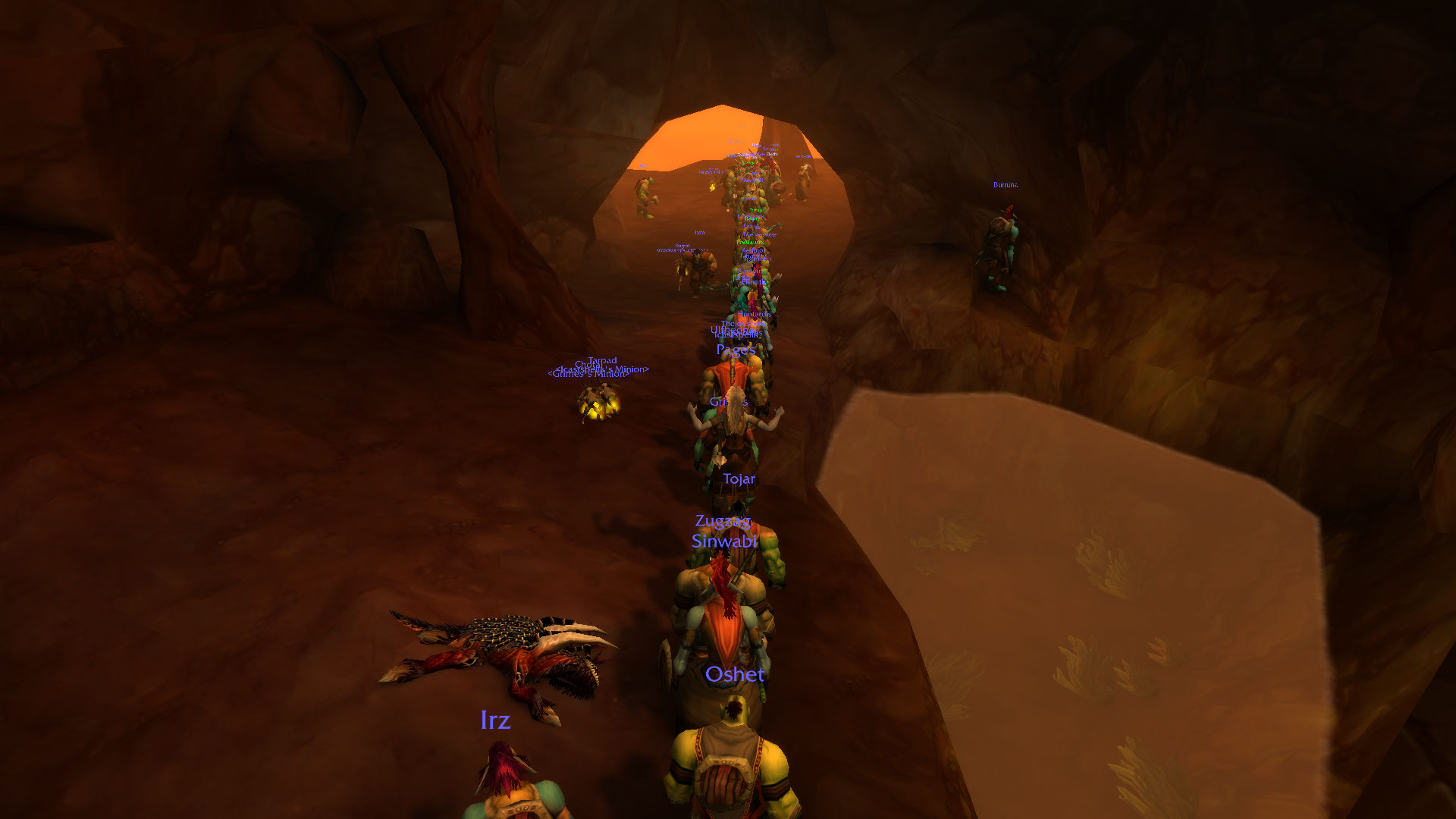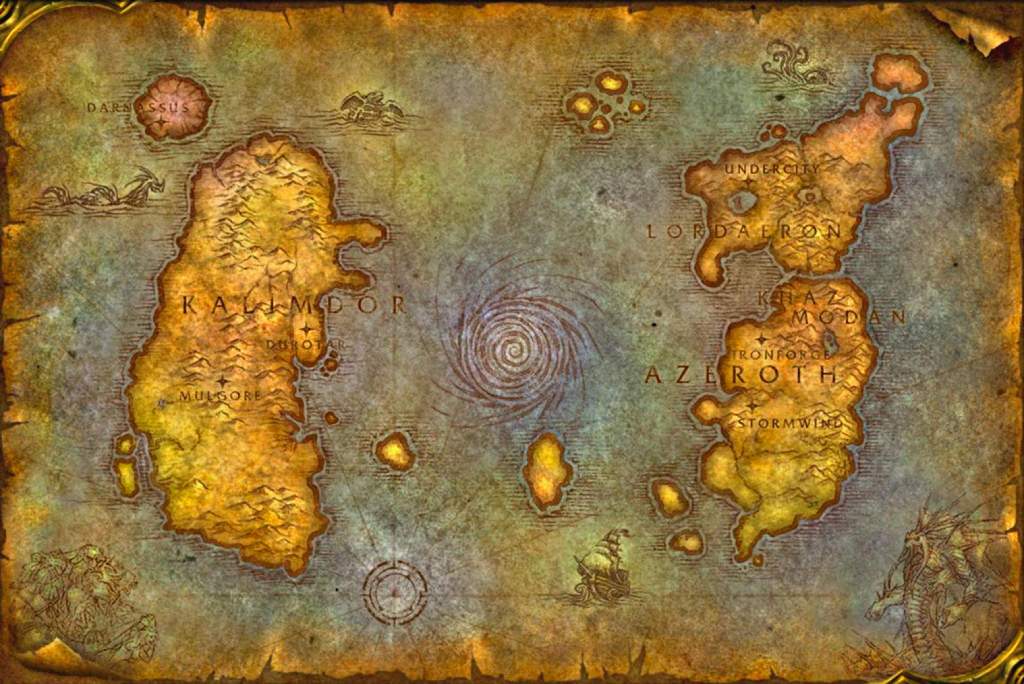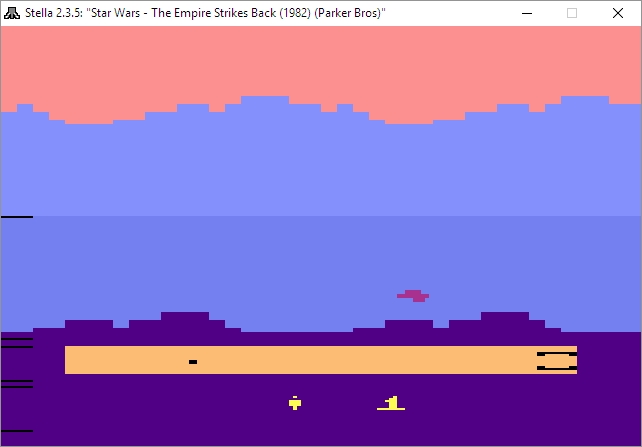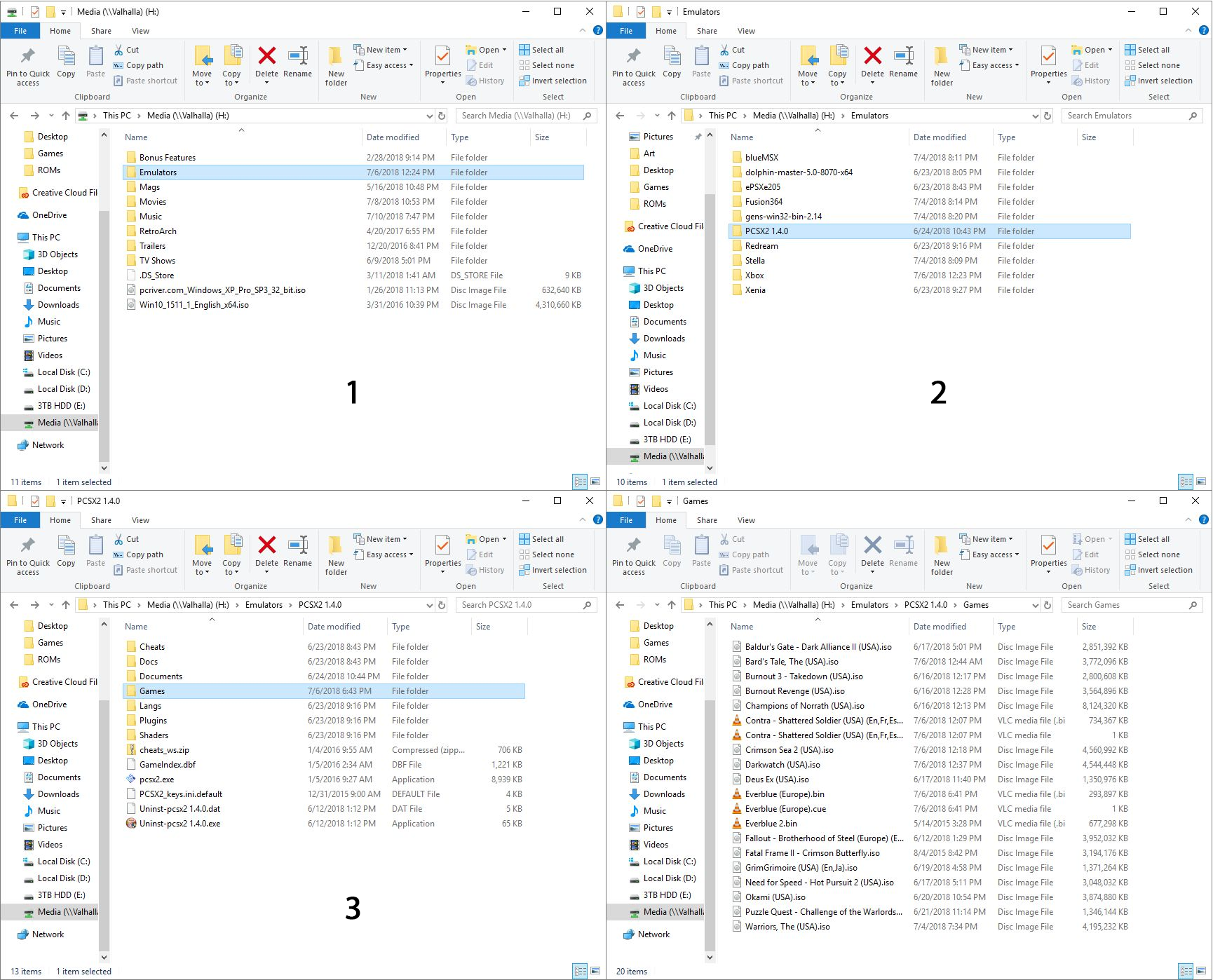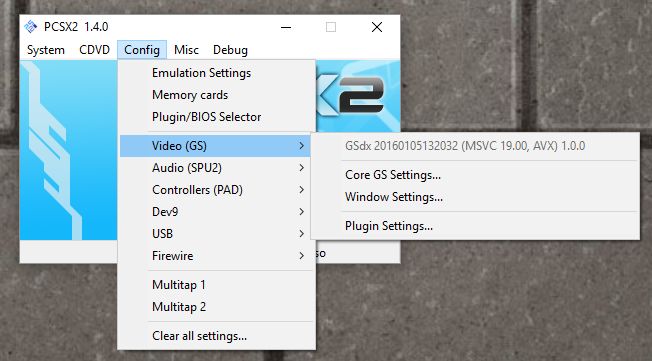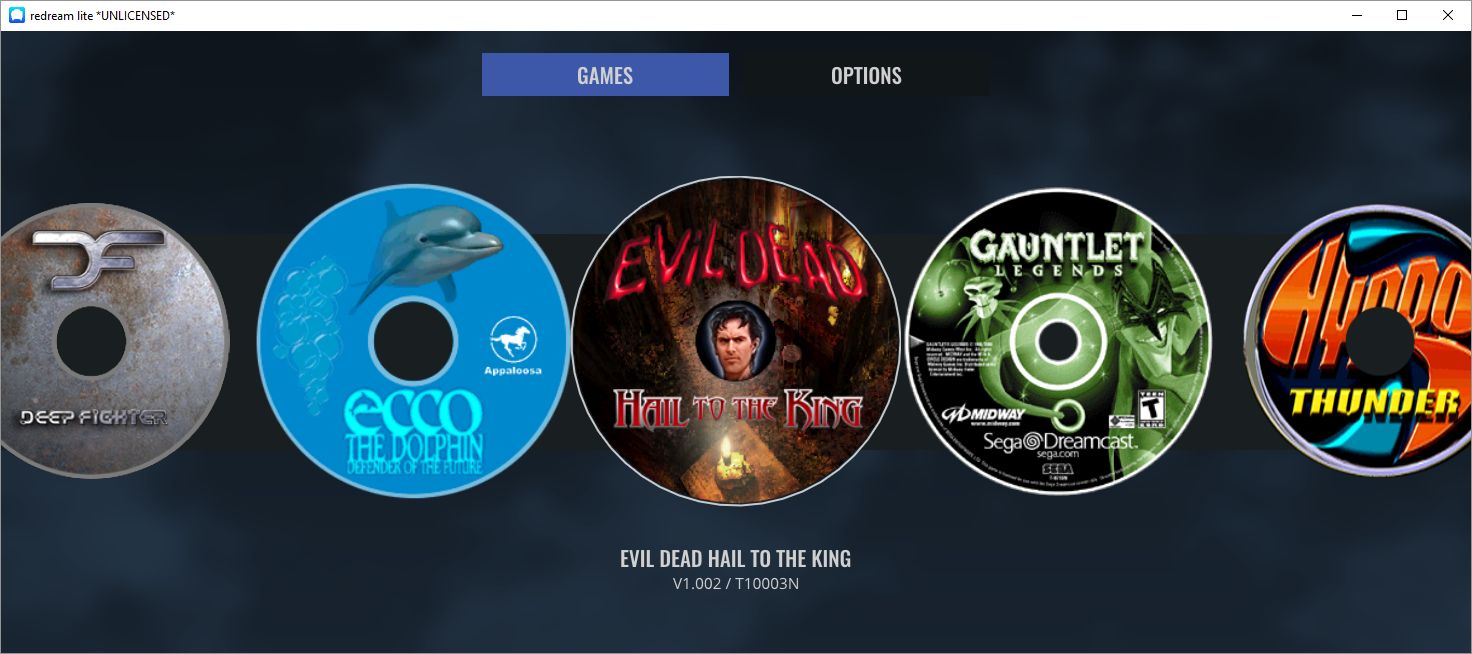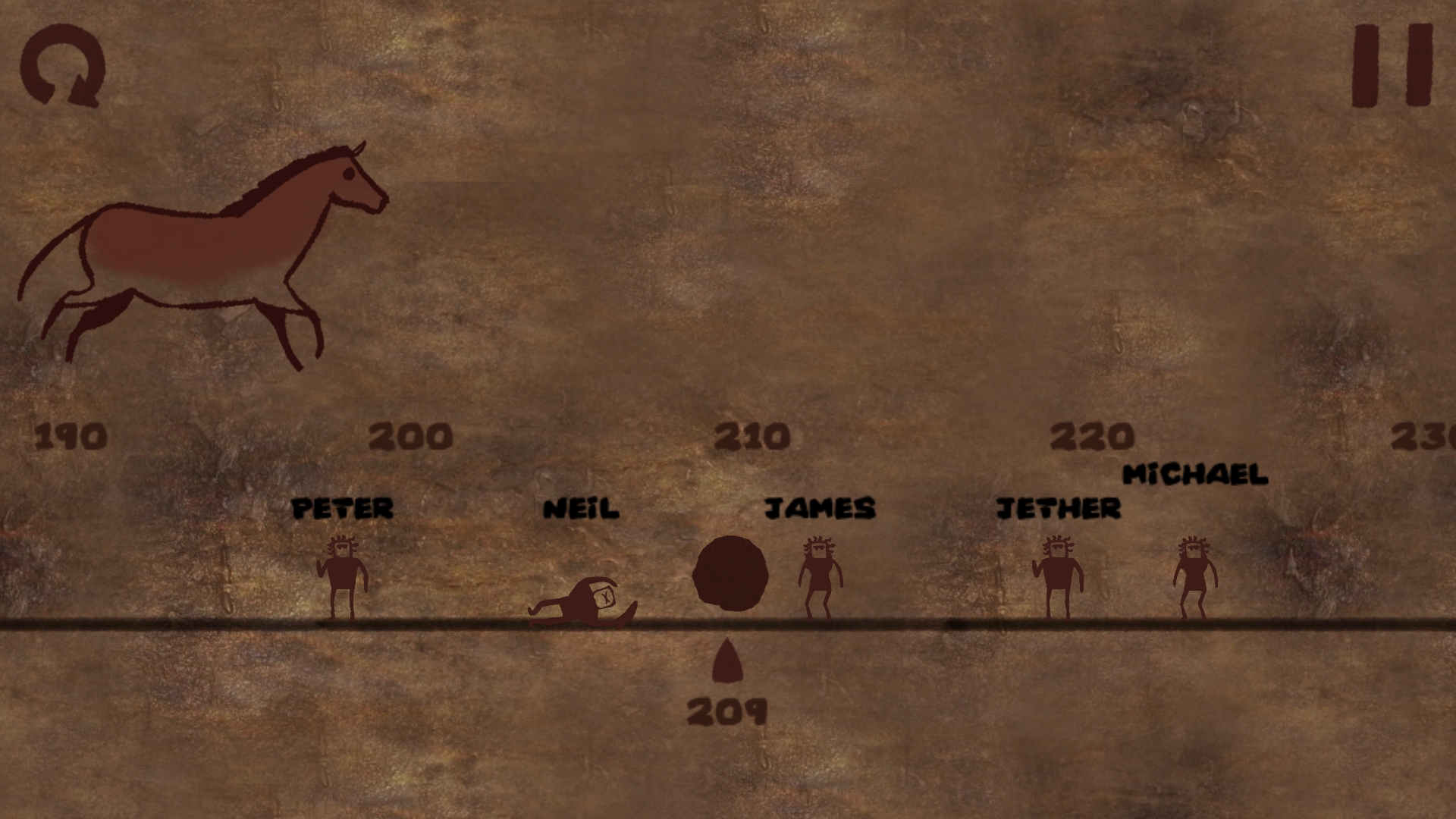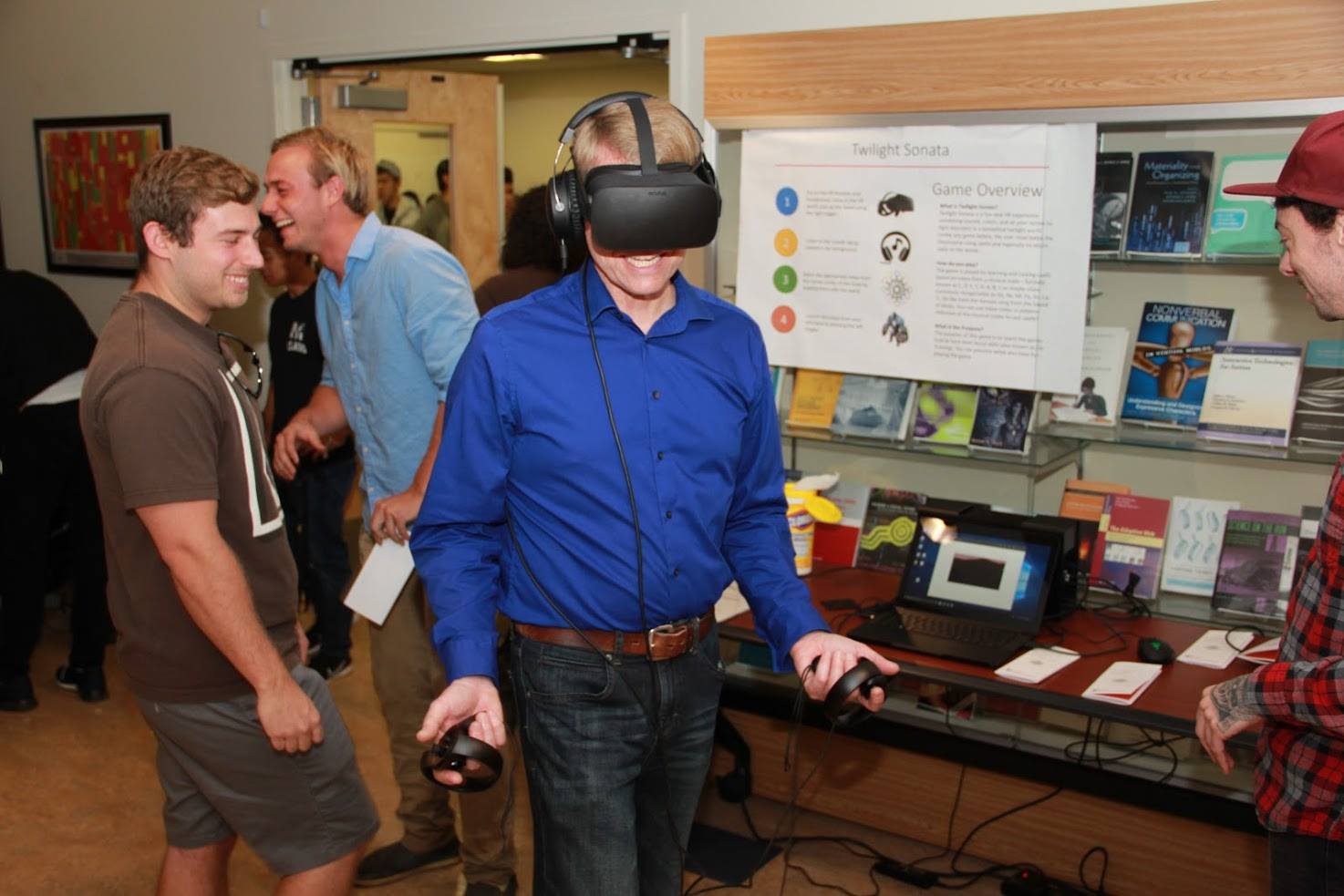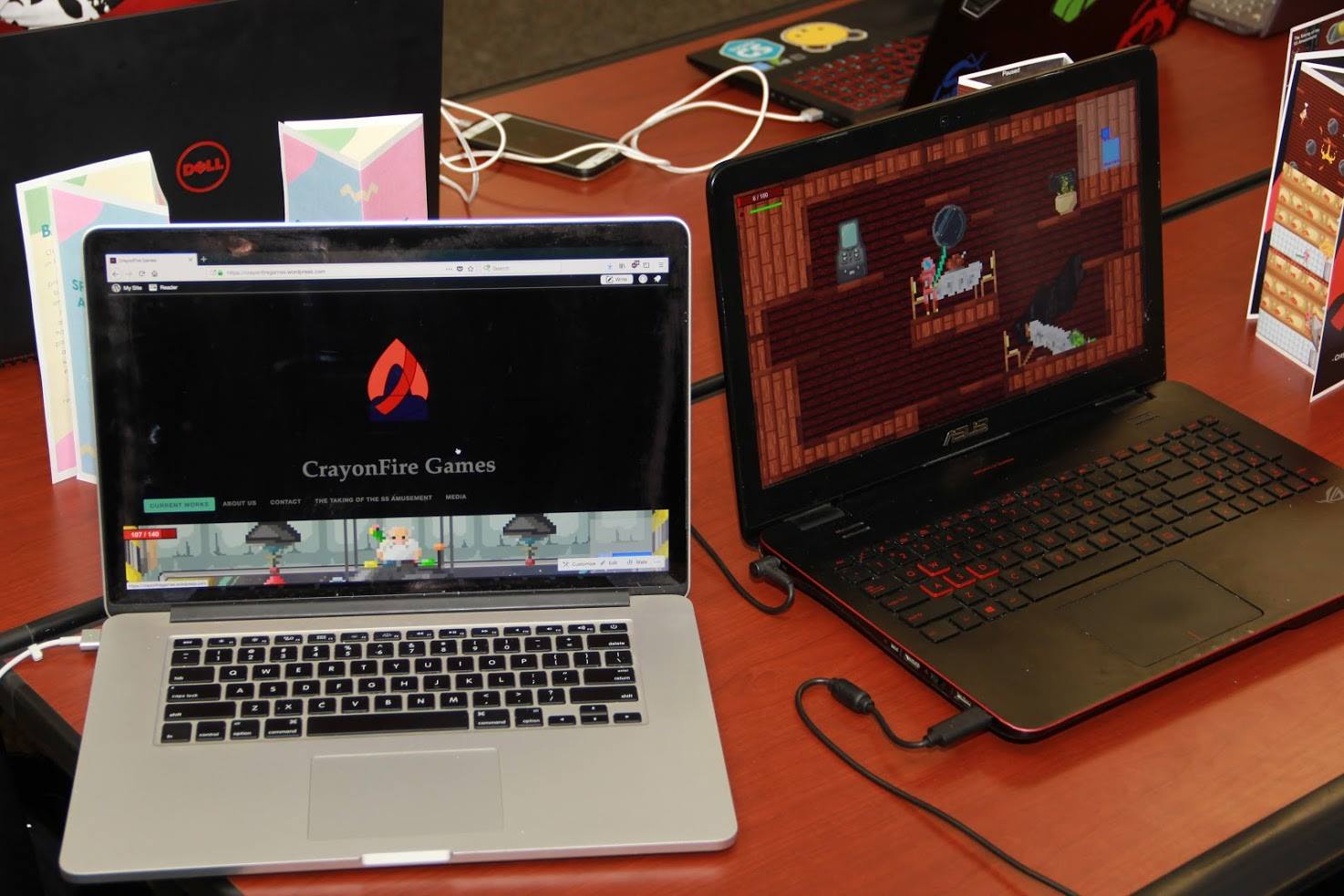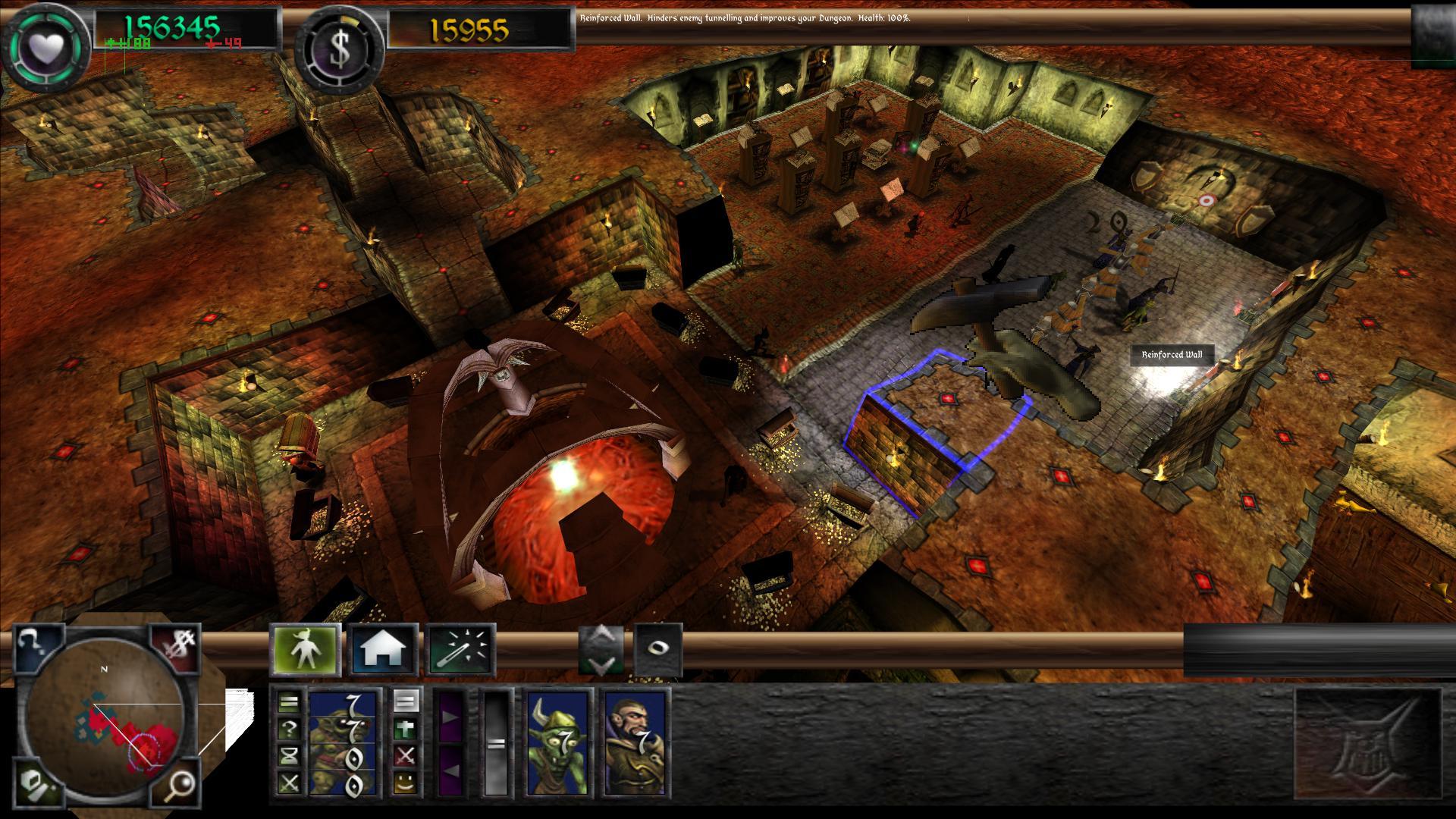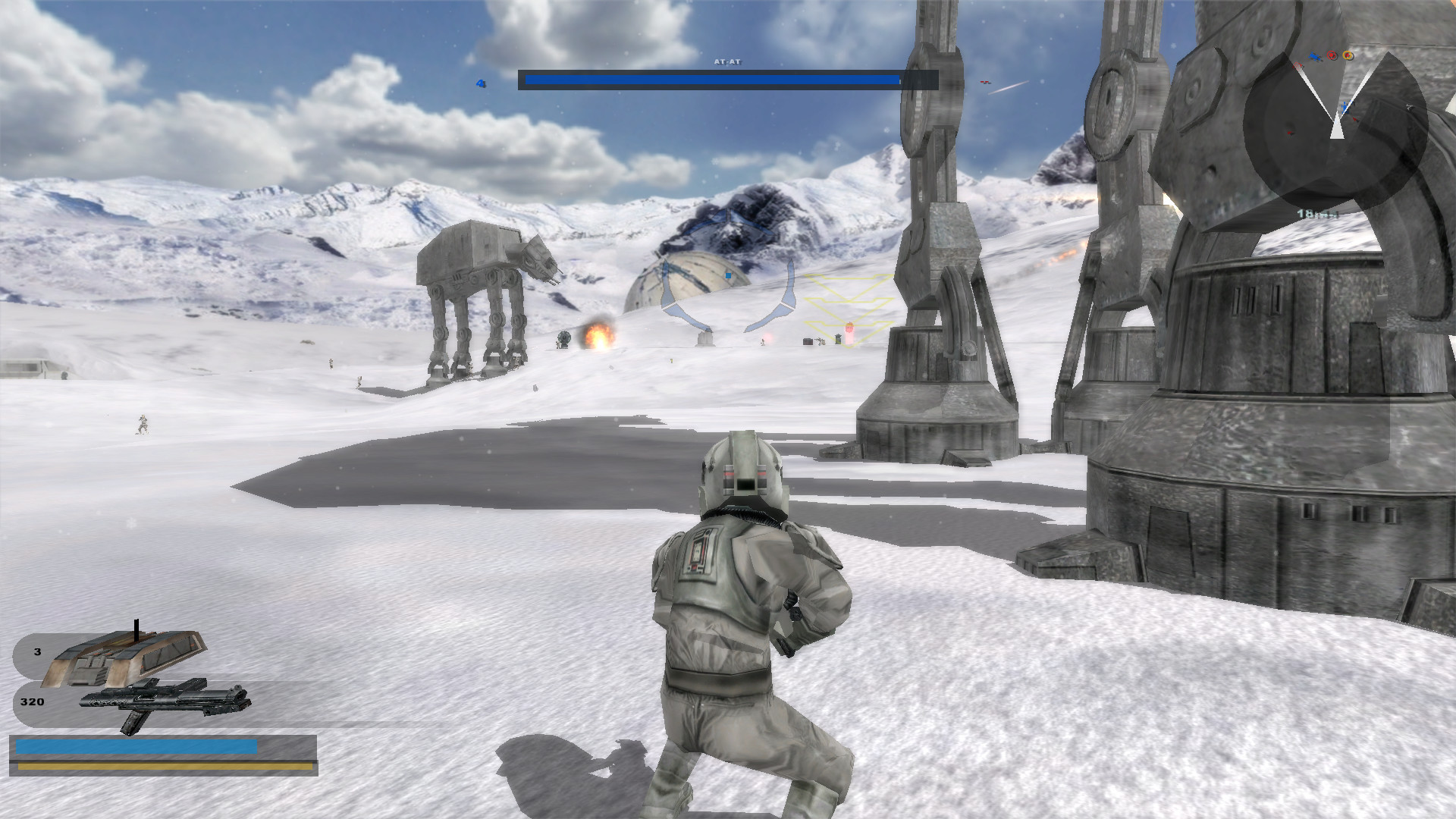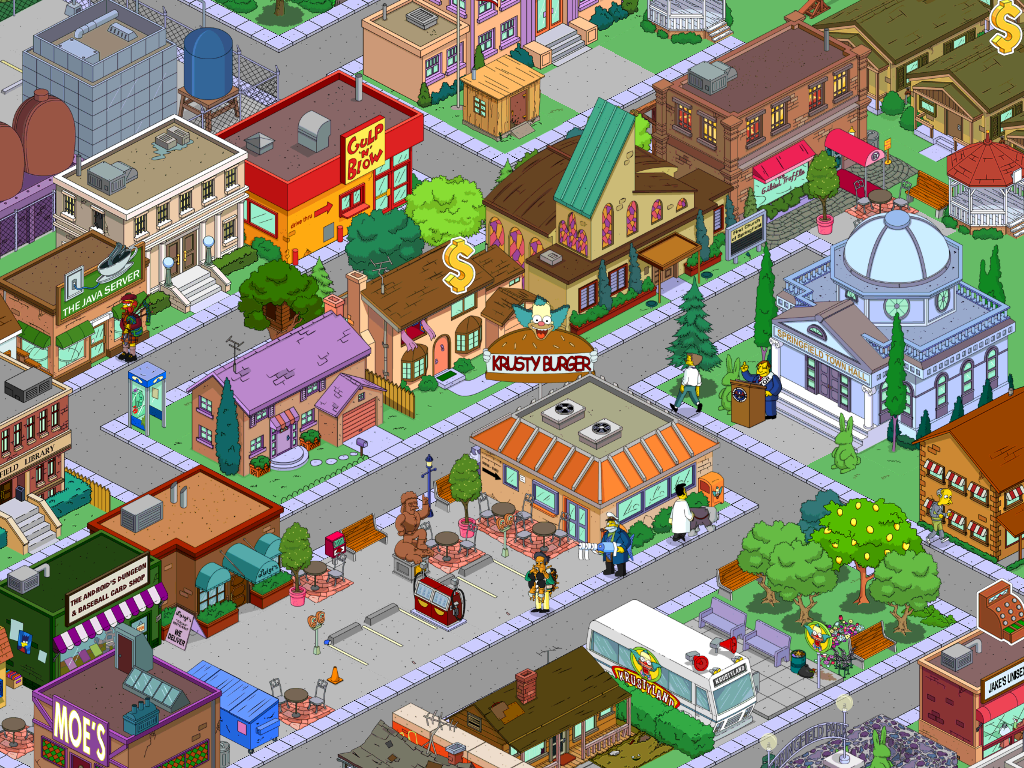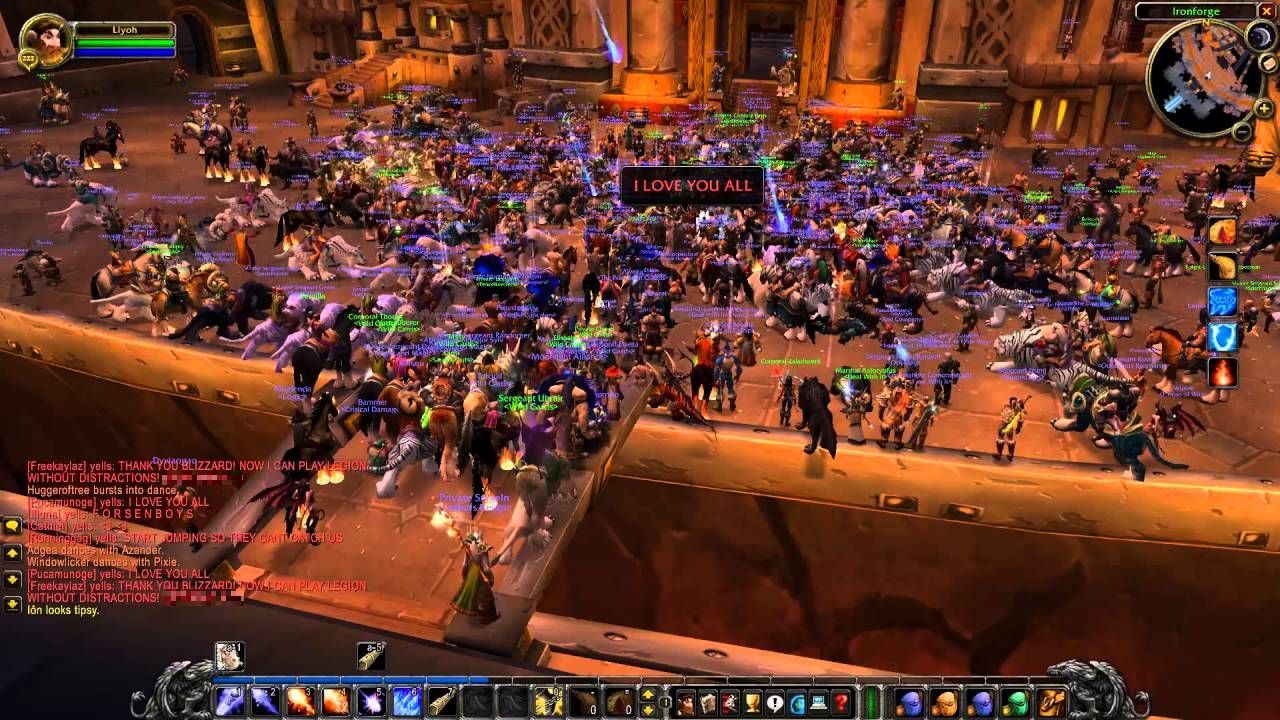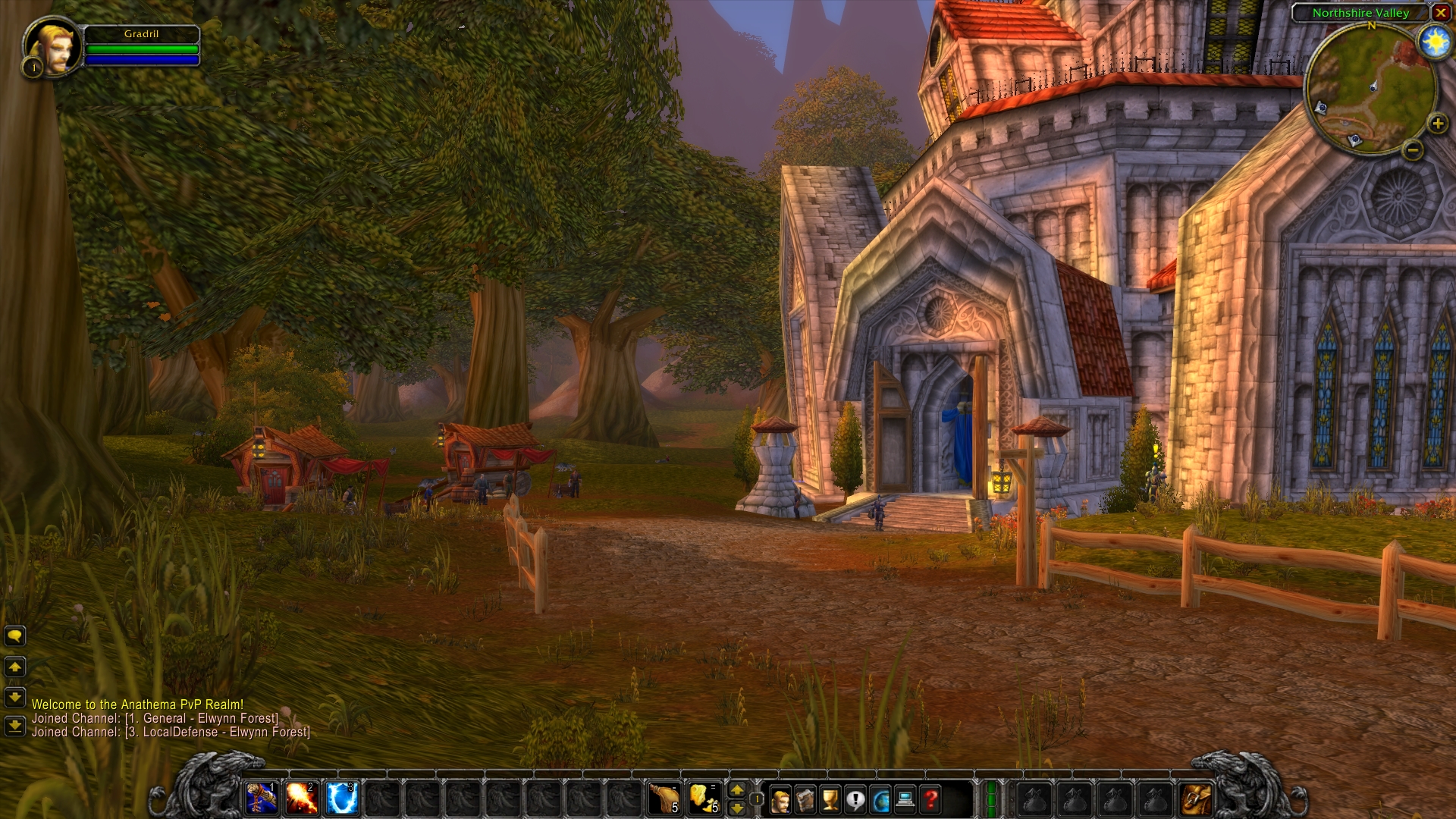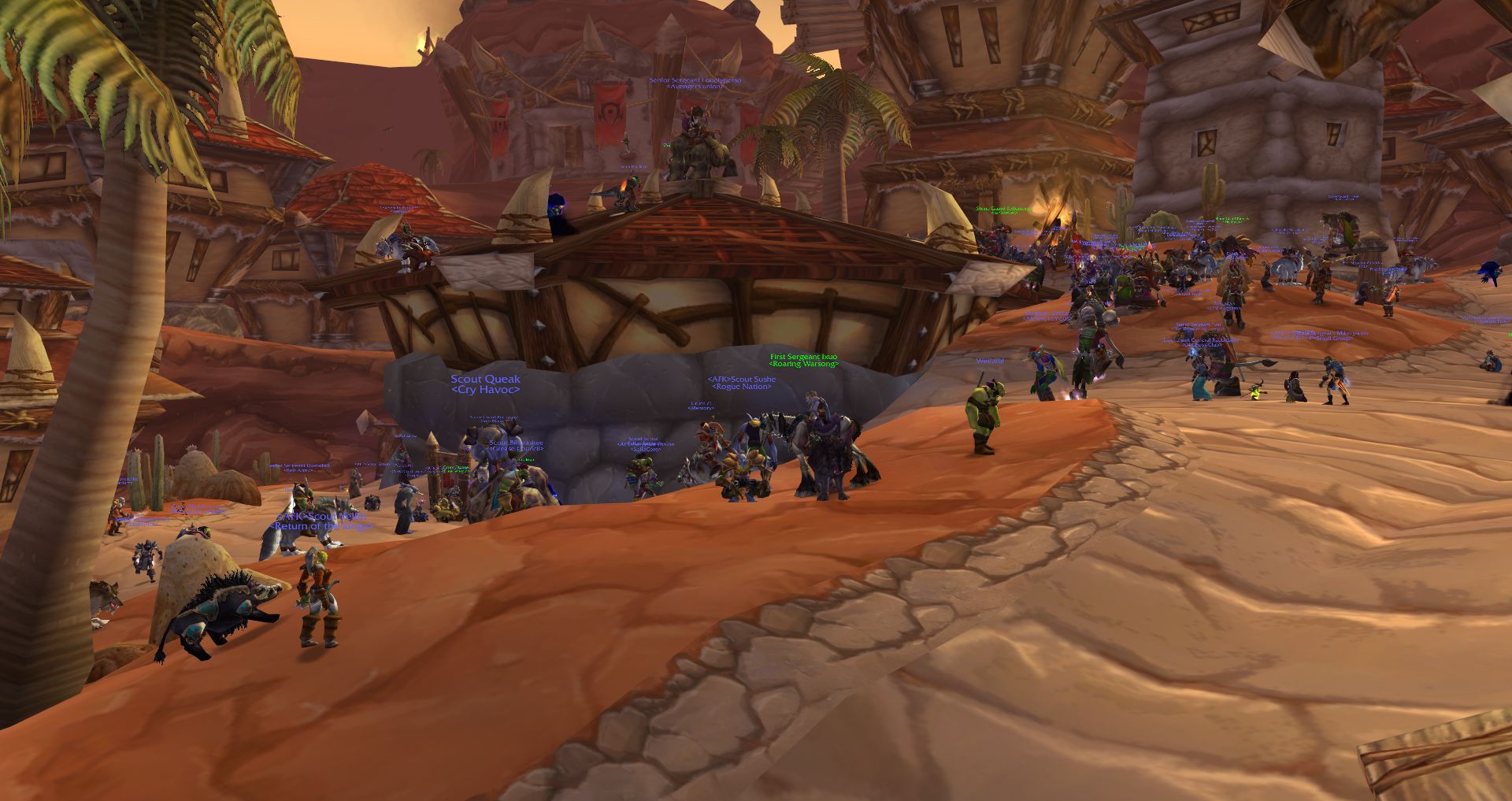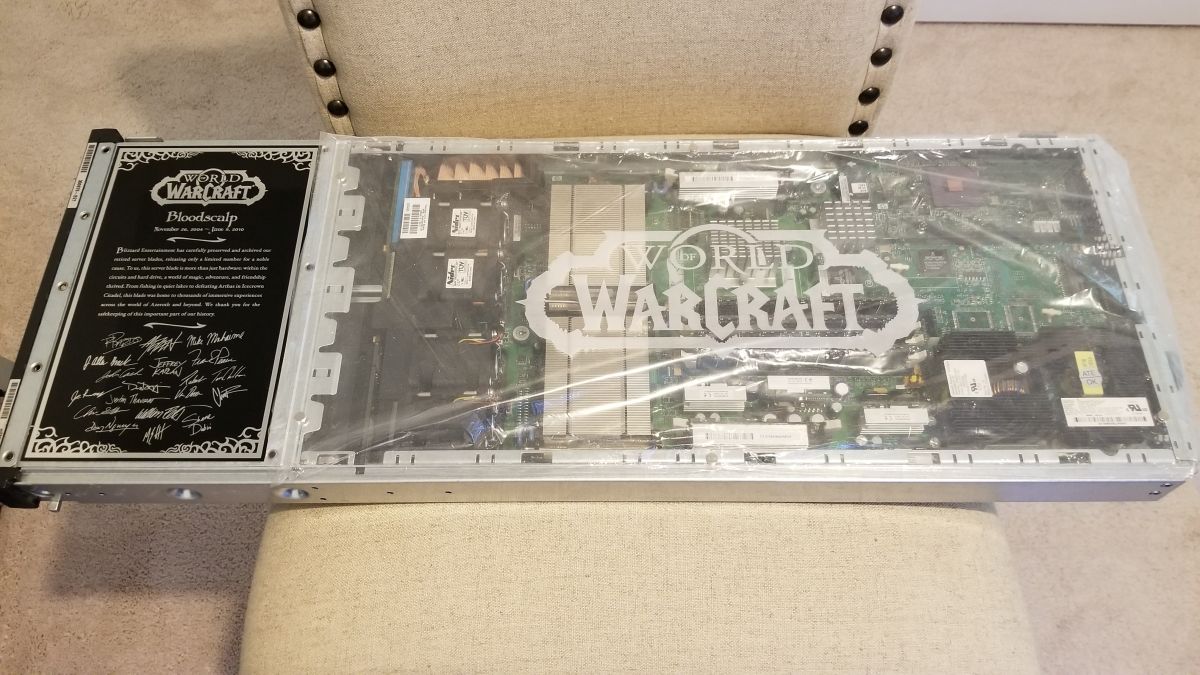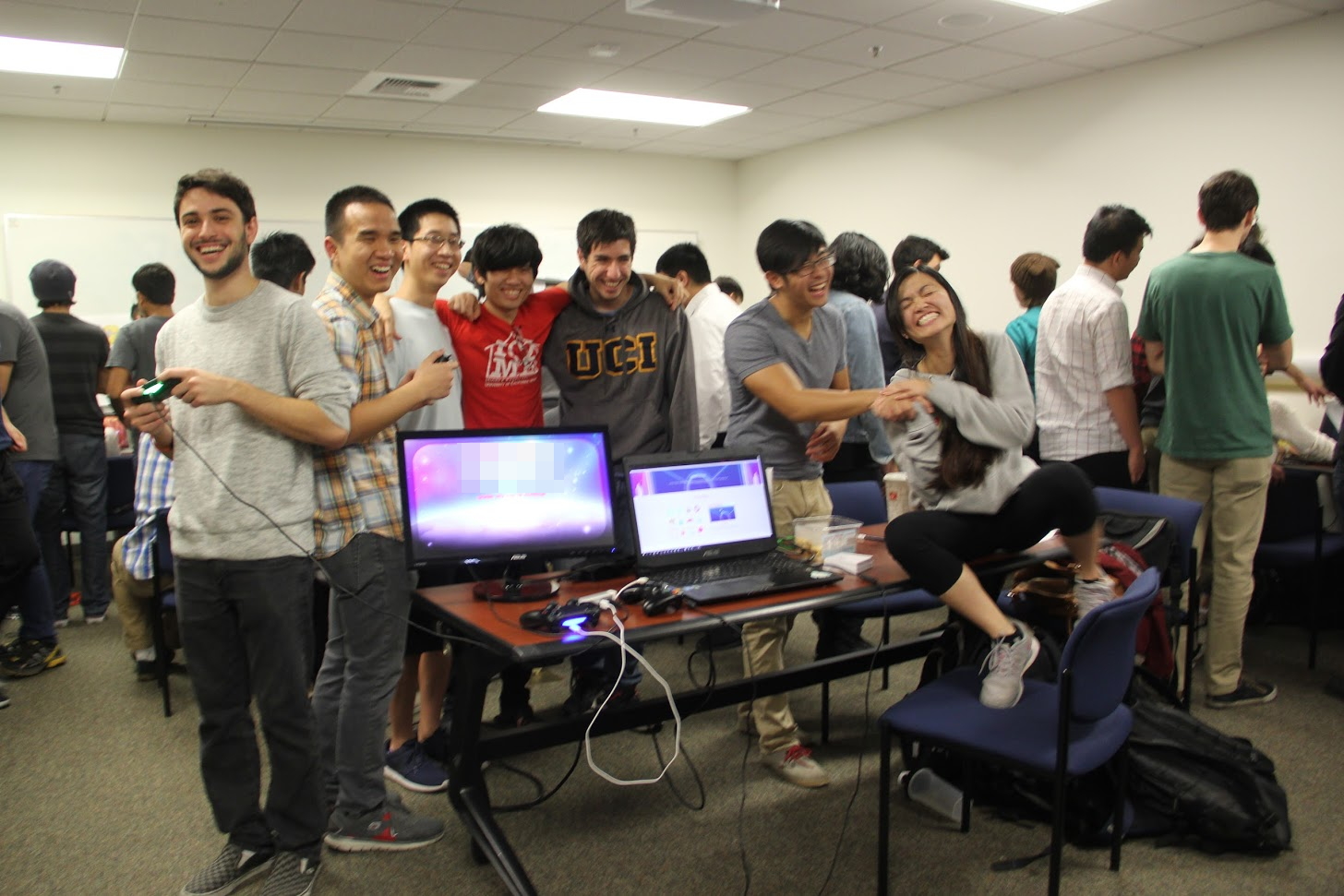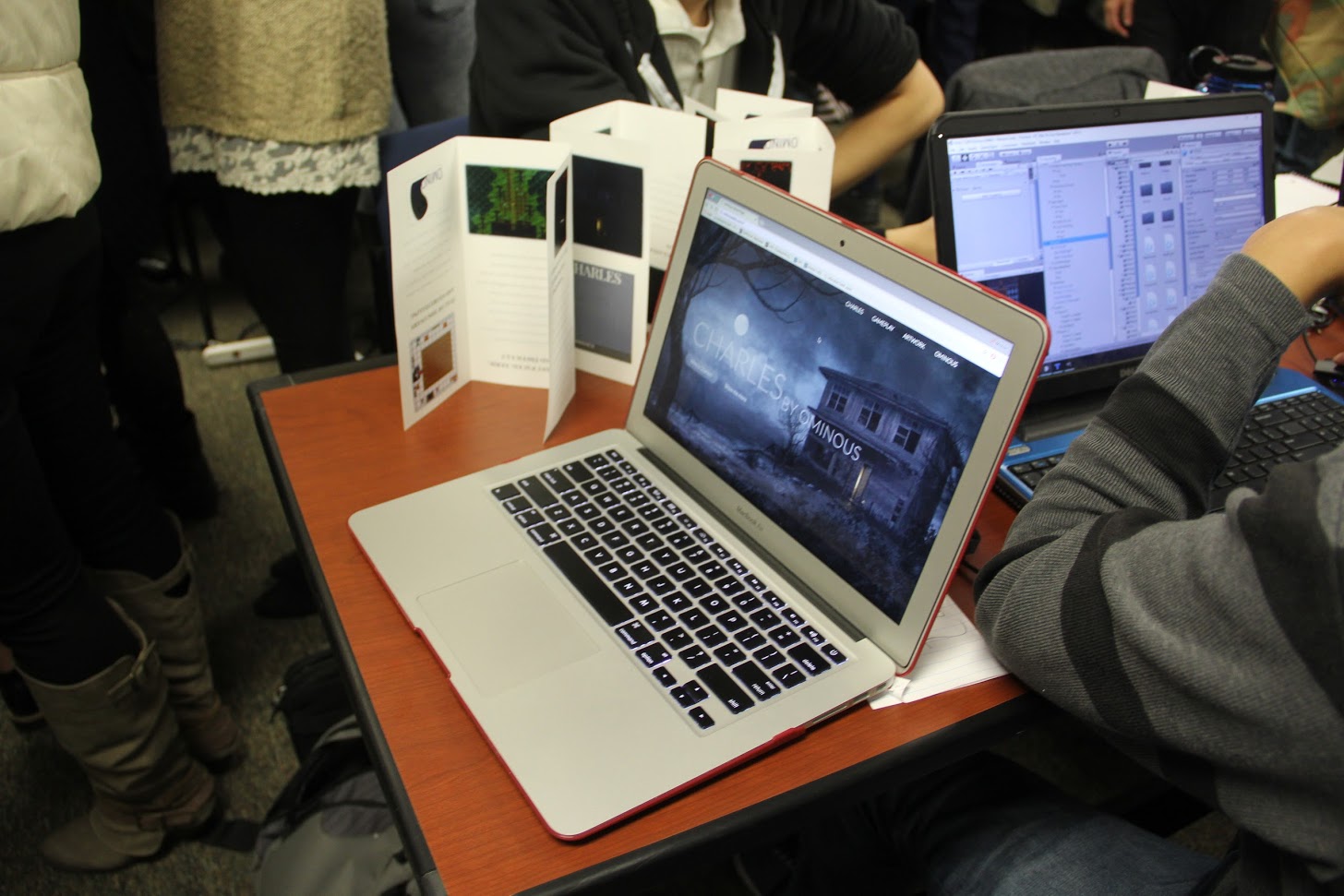Category Archives: Gaming
Returning Home: World of Warcraft Classic Comes Online

On August 26th, fans of the original World of Warcraft (henceforth referred to as WoW), and those who are just curious to see what all the hubbub is about, were finally able to re-experience the original game as it was when it first came online back in 2004, now colloquially known as ‘vanilla’. And boy did Blizzard deliver, complete with massive queues, disconnects, and crowding. But they have also provided what many people have been asking for for many years: The authentic and original WoW experience.
World of Warcraft was first released in 2004, a Massively Multiplayer Online Role Playing Game (MMORPG) in the vein of Everquest and Ultima Online before it. However WoW streamlined the gameplay process and created something accessible, that anyone could play, and eased players into the experience without being overwhelming. It was an instant, massive hit, and has continued to be a juggernaut even to this day. Attempts to topple it, even using popular franchises with similar gameplay such as Age of Conan and Star Wars Galaxies, couldn’t come close to WoW’s success.
In the game, there are two main factions: The Horde, comprised of Orcs, Trolls, Tauren, and the Undead, and the Alliance, comprised of Elves, Gnomes, Dwarves and Humans. Depending on your race, you could be one of several classes: A paladin, mage, warlock, rogue, warrior, priest, druid, hunter, or shaman, each with their own unique abilities and approaches to gameplay.
As the years went on, WoW evolved. What started out as a world with two continents, eight races, nine classes and a tight story to tell, ended up as what many consider to be a mess in terms of overly-streamlined gameplay (e.g.: quest markers and highlighted objectives / objects), homogeneous races and classes (e.g.: many classes were limited to certain races, but now that’s generally not the case; anyone can be anything. Another example: Undead could ‘breathe’ underwater, now anyone can breathe underwater for a comically long time), and simplified specializations that don’t allow for really exploring a particular class.
Combine that with the original story of the Horde V. the Alliance morphing into them working together and sharing quests and zones, a rambling main story with red herring side quests and endless grinding with things such as daily quests, as well as a confusing world structure (A new capital city, Dalaran, now has two separate locations in the game: One in Northrend and one in the Broken Isles. It’s the same city, but in two places, although there is lore for that), and people started to get weary.
Not that it was all bad, mind you. The ‘Mists of Pandaria‘ expansion, which introduced a continent known as Pandaria based on Chinese lore, along with a race of humanoid pandas known as the Pandaren, and the new class of monk, was very well received. Additionally, flying mounts and pets of many types became available as nice additions. But overall, the gameplay itself, the core experience, lacked.

Mists of Pandaria
While all this was going on, something known as private servers began to appear. These were privately run WoW servers that there recreated that original version of the game as it was when it was first released. There was no charge, and people flocked to them. The largest was Nostalrius, which at its peak had, according to Wikipedia, 800,000 subscribers and 5000 – 8000 concurrent players. Blizzard hit them with a cease & desist order, but the coverage of that was severe and intense, and it appeared that Blizzard noticed. I myself played on Nostalrius, and wished it to continue. An interesting aside about it is that when I dowloaded the client, which had to be done as a torrent, I was immediately – while the download was still happening! – sent an email from Cox telling me they had received an official complaint about my IP from Blizzard stating I was pirating the game.
But I digress. Blizard may have noticed, but also said very publicly during a live conference, that ‘you may think you want vanilla WoW, but you don’t.’ They had to eat crow on that, but they did so with grace and humility, and I respect them for being good about it.
They eventually announced that would be creating a classic WoW experience, and it finally came online August 26th, 2019.
I was excited for this too. Seeing the announcement of original WoW gave me chills. I loved original WoW, and was even in the beta so many years ago. It’s strange, because as I would read magazine articles and online posts about it, I didn’t have much interest. I heard the beta was coming and thought ‘why not?’ Well, it turned out to be lifechanging. I’ll never forget creating my first character, an undead warlock of course and of course on the server named ‘Bloodscalp,’ and venturing out into Deathknell, the undead starting zone. The purplish tint of my shadowbolt, the civilized undead, the unique, not-quite-cartoony but surprisingly colorful and detailed environments, and as I would eventually learn the incredible backstory and unique races, including the Native-American styled large bipedal bovines known as Tauren, a really unique offering for a game of this type. So much did I love it that I bought the Bloodscalp server on which I used to play when they were retired for an upgrade.
Eventually, though, after years of playing, it was sadly no longer the game I remembered. I stopped playing for a good number of years after I heard someone yelling in general chat that if they wanted to group with him for a raid, they ‘SHOULD LINE UP FOR GEAR CHECK’ and ‘DO NOT WASTE MY TIME’ and ‘KNOW YOUR ROLE AND DON’T ASK QUESTIONS.’ Remembering how the game was when it started, how everyone was incredibly helpful and pleasant, that one jackass really discouraged me, and he wasn’t even talking to me. That was after a couple of expansions had released, and for those of you familiar with the game it happened in Shattrath, a city and storyline I just could not get into anyway, and I logged off that moment and didn’t play again for five years at least.
Not only were these hardcore players becoming more common in current WoW, enemies became easy to defeat, everything is signposted, there’s no sense of accomplishment or earning your way, and the story, for me anyway, was just confusing and I couldn’t figure out what was going on. Original WoW does not hold your hand in any way; it’s unforgiving, and expects you to read the quest text and figure out what to do. When it was announced, to paraphrase an infamous in-game proclamation, I was definitely prepared.
There was some drama leading up to the event that I myself was caught up in. It was announced that two weeks ahead of release, players could log in and create / name their characters. I have characters I have played with for FIFTEEN YEARS. When I logged in to create my characters on the Whitemane server, which was my server of choice as it is PvP and PST, I was hit with a 45 minute queue and by the time I managed to get in all my names were already taken! Wheels was the name I desperately wanted, and I made numerous posts on the classic WoW reddit sub and in the Whitemane server sub as well asking if the person who had it would be willing to trade or even sell, but no luck. I ended up with Kneecap, which I actually like, but it’s not Wheels.
Well, once the servers came online, while waiting in the ENORMOUS Whitemane queue (see image below), I just happened to also be in the classic WoW Discord watching the live feed of people trying to get in drama when I saw a post shoot by stating Blizzard would be bringing three new servers online, including a PST PvP server named Smolderweb. Smolderweb! I liked Whitemane, but Smolderweb was far more badass than I could have hoped, so I waited. Waited…waited…and the second it came online I pounced, created all my characters, and got all the names I wanted! I couldn’t believe my luck. There was also no login queue, I got right in and grouped up with some great people and had a blast running around the troll / orc starting area. Players even lined up for specific quest targets in a very orderly and polite way. Everything ran very smoothly, there was absolutely no lag, and I couldn’t have been happier with the experience.
To be fair, I saw posts that showed the Alliance also lined up for their quest objectives, so it was good all around.
I find it telling that even though this is no longer WoW easy mode, and that everything has to be worked for (your first ten levels will be hard, until your class specializations start to kick in, and then it will be less hard but still hard), I’ve had the most fun I’ve had in WoW for many, MANY years, and I’m very glad to be back in the world that I left so long ago.
A win for digital preservation
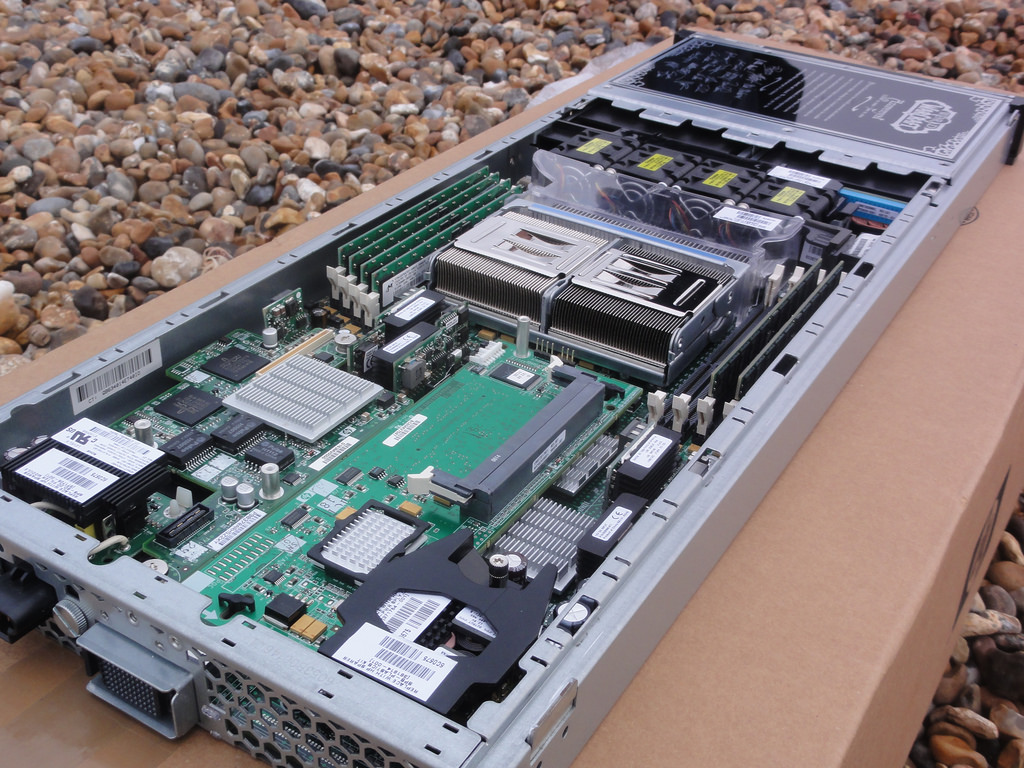
As many of you know, I am a big fan of older software and systems, even maintaining a small collection of vintage computer systems and software. Indeed, it is the software that is important, as hardware without software is just hardware, nothing more. Every piece of hardware needs a killer app to run on it, or people don’t buy the hardware in the first place. It’s why game consoles need to have a robust software lineup available at launch, or else risk being left behind for the entire generation.
Thing is, preserving physical copies of software is easy, procedurally, anyway. You have the physical software, and you digitize it while preserving the physical copy itself, and it could be a permanent record. of course, there are issues with maintaining the software in a runnable state, both for the digital version (are there suitable emulators available?) and clearly for the physical version, which is subject to all kinds of risks including environmental and technical. There is the issue of bit rot, an ill-defined term which generally refers to either a physical medium being unusable because as technology advances, the hardware used to read it becomes obsolete, or the general lack of performance of a physical medium overall due to the aforementioned environmental or other factors.
Even with physical copies, issues of the grey-area legality of emulators is always front-and-center, with the real focus being on ROMs. Nintendo recently shut down long-time and much-loved ROM site EmuParadise simply by threatening legal action. Curious, considering EmuParadise has been around so long, but now Nintendo wants to start monetizing its older IPs, and EP might put a bee in that bonnet. Also, ‘shut down’ isn’t entirely true: they didn’t shut it down but the site no longer hosts ROMs, and even though there is still a lot of information, the actual games being lost is a big problem. I have to go further out of my way to find ROMs, even for games whose companies, platforms, sadly even developers are long gone.
So why does this all come up now? Because we are in an age now where much of the software, data, and information we have is in digital form, not the physical form of old, and this leads to huge problems for historians and archivists such as myself. If something is only available digitally, when the storefront or host on which it is available goes down, how will we maintain an archived copy for future generations to see and experience? I have a Steam library with, at the time of this writing, over 300 titles that are all digital. there is no physical copy. So, just for argument’s sake, let’s say Steam closes shop. What happens to all those games? those VR titles? That one DAW? Will they just vanish into the ether? Steam claims if they ever shut down, we’ll be able to download them all, DRM free. But will we? As the best answer in that earlier link states, Steam’s EULA that all users are required to accept, states that their games are licensed, not sold. That may seem strange, but it has actually been that way for a long time. Even with physical games, you don’t actually own them and what you can do them outside of simply play them is exceptionally limited.
So how do we preserve these digital-only games? Whether a tiny development house creating an app, or a huge AAA title developed by hundreds of people: if the company shuts down or the people move on or whatever happens, how will we access those games in the future, 10, 20, 50 years from now?
This becomes even more of an issue when we have games with a back-end, or a server-side component. The obvious example is MMOs such as Everquest and World of Warcraft. What happens when their servers shut down and the game can no longer be played? How do we continue to experience it, even if for research or historical purposes? If the server code is gone, having a local copy of the game does us no good. As many MMOs and other online games continue to shut down, the fear is they will simply fade into nothingness, as if they never existed, but their preservation as a part of the history of gaming and computing is important.
Some brave souls have tried running what are called ‘Private Servers,’ which is server code not run, supported, or authorized by the developing company. Again, the most common example are World of Warcraft private servers you can join, which are not running the current code, but earlier versions which people often prefer and which brings up another interesting issue regarding the evolution of these digital worlds: Even if a game is still going strong, as is WoW, how do we accommodate those who prefer an earlier version of the game, in this case known as vanilla, meaning with the original mechanics, structure, narrative, and other gameplay elements that were present on launch but have since been designed far out of the game? Vanilla WoW is not officially offered although that will apparently be changing, but many private servers are immediately shut down via Cease and Desist orders from Blizzard, with one being shut down the day it came online after two years of development. Others manage to hang on for a while.
At the risk of going off on too much of a tangent, the reason I’m talking about this and why it has taken me six paragraphs to get to my point is that there has been a semi-wonderful ruling from the Librarian of Congress that essentially maintains an already-written rule that if a legacy game is simply checking an authentication-server before it will run, it’s legal to crack that game and bypass the check procedure.
Additionally, while that small thing includes the ability to allow legacy server code to run and be made accessible, it specifically can not be done so by private citizens, only a small group of archivists for scholarly / scientific / historic / other related reasons, and most importantly, the server code has to be obtained legally. That may be the biggest hurdle of all, as it is well known some companies sit on games and IP long after their market value has faded, preventing them from being released or even reimagined by the public. I’m hoping this is the beginning of a renewed push for legal support to archive and utilize legacy code and legacy server code to continue to preserve not just software titles of all types, not just games (and the new ruling includes everything), but the interim forms they took throughout the course of their development.
One additional note that surprises me even to this day: There is one online game that while very popular was eventually shut down by its parent company. That game was Toontown Online, and it was developed by Disney, a company well-known for aggressively protecting its IP. So it is especially surprising, that when an enterprising teenager who missed the world they had created decided to run a free private server, even renaming it Toontown Rewritten, Disney let it go! It has been up and running for a good number of years, has seen many improvements, updates and additions other than its terrible log-in client, and runs quite well. Here’s a screenshot of its current state, and as you can see it is still popular.
It still uses Disney-owned names and imagery, and has the unmistakable Disney aesthetic – there’s even a Toontown in Disneyland! If you want to see the proper way to handle this whole issue, once your game is done and abandoned, let an enthusiastic team who is passionate about the project and treats it with respect take over. It makes goodwill for you, a positive experience for them, and ensures your creation will continue to live on.
Just like old times: Running console emulators and PLEX on the virtual flat screen TV in Oculus Home

A couple of months ago, Oculus introduced a few flat-panel TVs (and a desktop monitor) into Oculus Home. That would have been fine in and of itself, however these TVs can have ‘panels’ embedded into them. Panels are essentially windows from your desktop, so if you had Word or Plex or chat or even a game session open, you could have it appear in a TV or monitor in your virtual home.
Naturally, my first instinct was to fire up one of my retro-console emulators and see if I could have it run by projecting it through one of the TVs in the virtual space. It’s almost a meta thing: Playing a classic console on a flat-screen TV in a virtual environment via VR. If it worked, since Oculus allows you to place as many of these as you wish, I could set up the custom gaming room of my dreams. I am happy to report it worked perfectly, and I am in the process of designing that gameroom right now! I’m thinking futuristic city as the backdrop, but we’ll see.
PLEX, which is movie-playing and streaming software for your personal media collection, also ran beautifully with no lag, and I’ll talk a little about that towards the end.
Before I get to the results, let’s talk about emulators. Emulators trick your system into thinking they’re the console they’re emulating, and I mean that they really trick it. Whatever shortcomings the console itself had, so will the emulator (and possibly a few more, but we’ll get to that). If a bug appeared in a game, or the console just quite wasn’t fast enough to push a game, that will be replicated during emulation. Atari 2600 emulators will even show racing the beam errors, in which the next line of video won’t be drawn if the emulator is still carrying out logic operations. In the following image, which shows The Empire Strikes Back for the Atari 2600 running in the Stella emulator (Stella was the code name for the console during development), if you look closely you’ll see black lines down the left hand side of the image: Those are racing the beam errors, even though it’s not a CRT and not even a console! The point is, when you’re emulating, the systems is the console.
Not only that, the games are actually the games, not some reprogrammed nonsense. An ISO, for example, is an exact bit-level copy of digital media, so someone will put the original game disc into their PC’s optical drive, or sometimes they’ll use the console itself with special connections, and use special software to turn that disc or cart into a file. Other times, the ROM chip itself will have to be ripped using a ROM (EEPROM) burner.
The point is, with an emulator, you’re getting the actual console experience with the actual games and all their flaws or lack thereof, not some hokey recreation. It also means some games may not work all that well, or at all, but that’s rare.
Generally, emulators are not terribly difficult to set up and get running. Each has its own quirks, but once you start experimenting you’ll be hooked, not to mention surprised at (generally) how well they run.
I use many emulators, and I’ll give you a crash course on setting them up. All you really need to know is that you need to specify a folder that contains your games, and you can call the folder anything you want: Whenever I set up a folder I’ll call it either ‘Games’ ‘ROMs’ or ‘ISOs,’ but you can use anything. Speaking of the games, those files can come in several forms: Some emulators allow for zip files in the games folder, others will require an .iso, .bin, or possibly other, specific file such as .gcn which is for the Nintendo GameCube. Some can use whatever you throw at them. Additionally, for the later consoles, you’ll need a BIOS file in your games folder as well, and they can generally be found with a low-effort web search, as can the games themselves.
Here’s an example of how the directories work, and these are almost always assigned during setup, although you can certainly set it through the options as well. For clarification, I run mine from a network drive, which is nice because I can save a game and then pick it up again from any PC in the house, or on the planet. Speaking of game saves, the emulators take care of setting up memory cards for saving games as well, however you can also create ‘Save States’ at any point in a game regardless of how its save structure is set up. So if you have to leave or otherwise shut down the emulator but haven’t reached a checkpoint, you create a save state, then load that instead of the save from within the game itself. You’re essentially saving the state of the emulator, not the game.
Here’s an example of setting up the games directory: In the image below, in image ‘1’ in the upper left, you can see I have an ‘Emulators’ folder, and after opening that, in image ‘2,’ top right, I am selecting the PCSX2 folder, which is a PlayStation2 emulator. Then, in image ‘3,’ lower left, I have created a folder called ‘Games’ where I keep all game files, and finally the last image shows the .iso and .bin files that represent that games I have for that emulator. On the other hand, my Gamecube / Wii emulator, Dolphin, has a folder called ISOs where I keep all my games, even though not all of them are actually .isos.
The next big thing is that I have an XBox One controller connected to my PC, and any controller you use has to be configured. The initial controller setup, although straightforward, can be moderately time-consuming, but you should only have to do it once. For most emulators, you’ll need to go through and indicate which button on the controller does what, and you do that by clicking on each function in the emulator, then pressing the button / pulling the trigger that you’d like to assign. Below are images of the PCSX2 controller configuration screen, and underneath that the Dolphin controller configuration screen, and you have to click on each function then press / pull the corresponding control on the controller itself. Once that’s done, controls should be all set. Ultimately, it’s a really nice way of doing it because you can set the controllers any weird, wacky way you’d like.
The only other major issue you are likely to run into is the graphical settings. Older consoles weren’t designed with 4K TVs in mind, many never even considered widescreen! Although most games will work fine, each emulator will have its own peculiarities when it comes to this, and they all offer EXTENSIVE graphics customization. PCSX2, for example, allows you to use OpenGL, Direct3D9 or Direct3D11, and it’s fascinating how a game won’t run under DX9, but will run perfectly under DX11, or vice versa, and I have seen many variations on that. I also, for that particular emulator, set resolution to at least 2x native; then it will run surprisingly well even on a widescreen 4K TV. And of course, it allows you to customize graphics for the emulator in general, as well as specific tweaks for the renderer you choose.
When it comes to actually selecting a game, some emulators are more user-friendly than others. Prettier, I guess I should say. PCSX2 only offers up a straight file selection window, while Dolphin and ReDream, a Dreamcast emulator, provide lovely selection menus. Being an HCI person I prefer that, but the PCSX2 barebones method works just as well.
So now that we have the details out of the way, what about running them on the TVs in Oculus home? I’m glad to report it works perfectly! There is, however, one big caveat: You can choose to embed the emulator window that’s displaying the game, however the window won’t be listed as a panel if it’s fullscreen, so you’d have to window the emulator on the desktop, then embed the window, then maximize it on the desktop. The better choice is to fullscreen the emulator window then embed the desktop itself. If you do that, it will work perfectly, with no lag (either visual or input), no jitter, no performance hit. For PLEX and even for a couple of emulators, if they’re fullscreen, Oculus Home won’t recognize them anyway so you’ll have to embed the desktop no matter what: It’s just a better all-around option.
It also works for running MAME through the arcade cabinet, as seen below:
If you’re interested in running PLEX, I have a separate video series on ripping videos and setting up PLEX (part 1 (Ripping), part 2 (PLEX)), and while it’s also not difficult, it’s beyond the scope of this post. Even so, the process of embedding is the same, especially since, as mentioned earlier, PLEX doesn’t show up in the panel selection menu anyhow.
Here’s the video showing four different emulators running on the Virtual TV in Oculus Home, as well as PLEX running a streaming rip of Coco from a network drive, and there is also a wall-mounted TV option along with a computer monitor. It all worked incredibly well, much better than expected.
UCI team wins the 2018 IEEE GameSig competition!

Once again, a student-based game development team from UCI has been declared the winner of the annual IEEE GameSIG game development competition; that’s them in the main image. The competition, held every year and featuring games developed by student teams from multiple regional colleges and universities including UCI, Fullerton, Chapman, Cal State Long Beach, USC, and others, brings a narrowed-down field of ten finalists from this year’s original field of twenty; these ten games were the ones the review and selection committee, of which yours truly, meaning me, is a member, felt were the cream of a very rich crop. Yet even with all that fierce competition, UCI won, and in fact has won for the last seven years straight. It’s held at a different campus every year, each hosting the competition on a rotating schedule, but no matter where it’s held, UCI always brings home the trophy. I’m co-Chair of the reviewer committee along with professor Dan Frost who has been doing it since the beginning but recently retired, and one of the organizers, so I’ll have my work cut out for me next year as the 2019 competition will be held at UCI.
The final award winners, their respective institutions, and the awards they won for this year were:
Another outstanding Computer Game Development showcase!
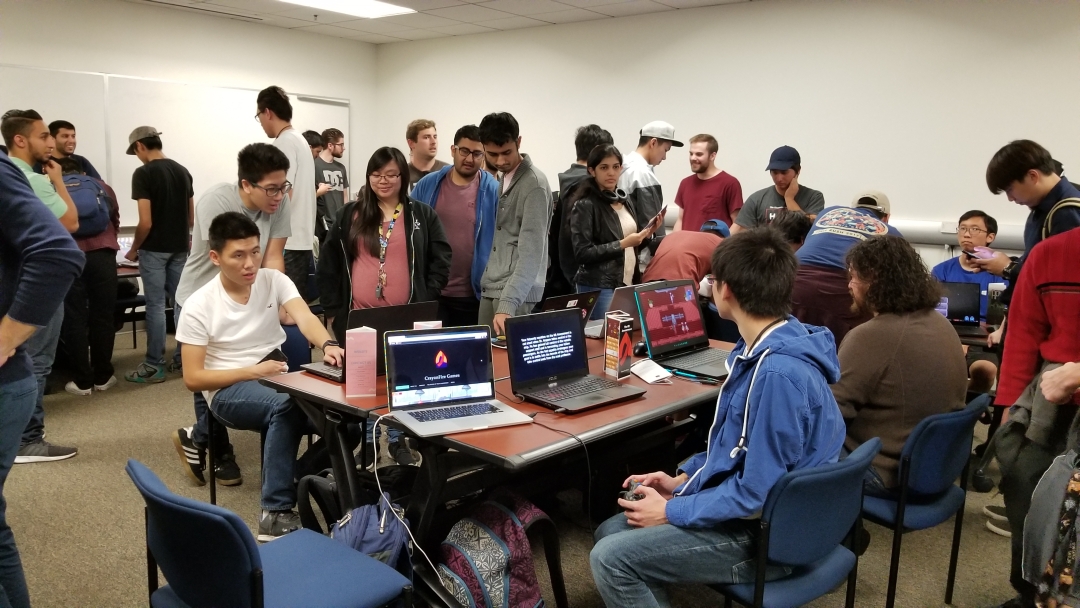
The quarter has finally ended, and with that comes this year’s Computer Game Development (CS 113 / INF 125) showcase, open to everyone – all faculty, staff, students, and others interested in game development. As always, the titles on display were, overall, of very high quality. Some were absolutely incredible, and I’ll highlight one of them at the end of this post, but I am always incredibly impressed with the range of concepts, ideas, and designs students come up with. From a potato trying to escape a kitchen, to an engineer who can hop back and forth between our world and the spirit world, to a game where you play as one of several geometric shapes each with their own ability, to a VR game – our first ever – to teach people musical intervals, all the games on display were incredibly unique. Along with having our first VR project, this was also the first time ever that anyone in the class used the Unreal Engine; I’ve been trying to get that to happen for years, and this quarter two groups, including the VR group, used it!
The standard is still Unity, of course, which is perfectly fine. Hey, if there was no Unity, there’d be no Rocket League, and we can’t have that.
Even more than the games that are incredibly polished and advanced, I come away most impressed with the groups who began the quarter with no knowledge whatsoever of game design or the tools to create something interactive and playable, and in a mere ten weeks created a game that could be played and that was even enjoyable is the most rewarding part of the class. They are the most proud of what they accomplished, and deservedly so.
There is always a game that stands out among the rest, and this time was no exception. Before I mention them, however, I need to say this is no way a denigration of the other projects. Everyone did a great job, presented creative ideas, put in a lot of effort, scrambled to learn new technologies, and they all deserve praise and credit. That being said, there is always one project that is all but ready for public release, and this quarter’s winner in that category is a visual and storytelling triumph, The Taking of the SS Amusement. Did I mention I suggested that name in a nod to The Taking of Pelham One Two Three?
The team named themselves CrayonFire games. The story behind that is a perfect example of the way all names should be decided; in a completely accidental and organic manner. During a Slack chat, someone mentioned a canyon fire that was happening here in SoCal, and another group member misread ‘canyon fire’ as ‘crayon fire’ and became understandable confused. And that, my friend, is how great company (and band) names are born.
The group was also lucky in that everyone involved was a gamer, and passionately so, and double lucky in that one of their group members had extensive Unity experience and coded games as a hobby, and triply lucky in that his roommate was an art major who agreed to the pixel art for them and created multiple masterpieces, as least as far as pixel art goes. The animations and behaviors of each enemy, which are robot chefs and stewards, by the way, is absolutely perfect, with my favorite being the food cart-pushing robots who charge the player then stop to wipe their brow even though they’re robots, and the final boss who presses the appropriate colored button to launch an attach which drains a battery meter. There are also parallax stars visible through windows, and a subtle before and after in the title screen. The game is challenging, expertly designed, and beautiful. Again, this is not to take away from other projects, I was happy with them all. But this game is special.
Their website is crayonfiregames.wordpress.com (they had to create a website as part of the course requirements), and I have embedded their promotional video below. I’ll see if I can make the game available for download – it’s definitely worth a play.
But again, congratulations to everyone in the class, there was so much good stuff on display it took longer than the two-hour showcase to go around and evaluate them all. I look forward to it every year, and for all the hard work the students have put in over the course of the quarter I know they really appreciate the opportunity to show off their achievements and accomplishments to everyone, and the feedback, both internal and external, was very positive all around.
On a relevant side note: I am trying to set up a repository of all the games that groups created for the class, however that is still in planning stages so it’s just a sidenote for now, however I have high hopes we can use it as a central hub to highlight all the games created in this class over all quarters. If it happens, there will definitely be an announcement made here.
State legislator sets up YouTube channel covering his fight against predatory videogame practices

I hope, I mean I really hope, that Electronic Arts has finally gone too far. First, let’s not forget that when they were first formed by Trip Hawkins back in 1982, their approach was that developers were artists and they treated them that way. But things changed. They have been developing disgusting, money-grabbing pseudo-games for a long time now, and doing so with relative impunity. From the atrocious, insulting release of Dungeon Keeper mobile, a grotesque violation of the groundbreaking original series, the remake of which requires you to either wait for extended periods of time before your imps could continue to break down walls or buy crystals for real money so you can continue playing, to their more recent release of Need for Speed Payback which has you apply cards to cars in order to spec them out, however the cards are limited to only one car and they appear as a slot machine gameplay mechanic, the results of which are supposedly random. Never mind the idea that using cards as a means to upgrade cars makes no sense in the first place, nor does the random acquisition – those aren’t how upgrades work: remember the concept of ludonarrative dissonance? Racing games usually have you earn money by winning races and using that money to buy upgrades that you choose to fit your driving / playing style, which makes perfect sense. Just listing these two examples makes my blood boil, for many reasons. I have been a fan of Need for Speed for a long time (especially the police chases), and Dungeon Keeper, a game in which you design a dungeon to attract monsters who defend against invading heroes, originally released in 1997, is a game I spent many hours with and whose brilliance shines to this day. You could even possess the monsters who made their way into your dungeon and see it in a first person perspective.
And that’s the core of the issue. It used to be that when you bought a game, you bought the whole game. Games were designed as complete, compelling experiences meant to tell a story or provide an experience. You played the game, and either that was it or you played it again, perhaps trying new tactics or exploring new areas. Now, however, games are simply vehicles for monetization; It is determined how a property can be monetized, in other words how can it be developed so that once people buy the game they will need to continue to pay to fully experience it, and then a game is developed around that. They are not designed to be a game, to be fun, they are designed from the ground up to get you to keep paying. Look at this loading screen tip from Madden mobile for further proof: They outright tell you to buy ‘item packs’ to improve your game!
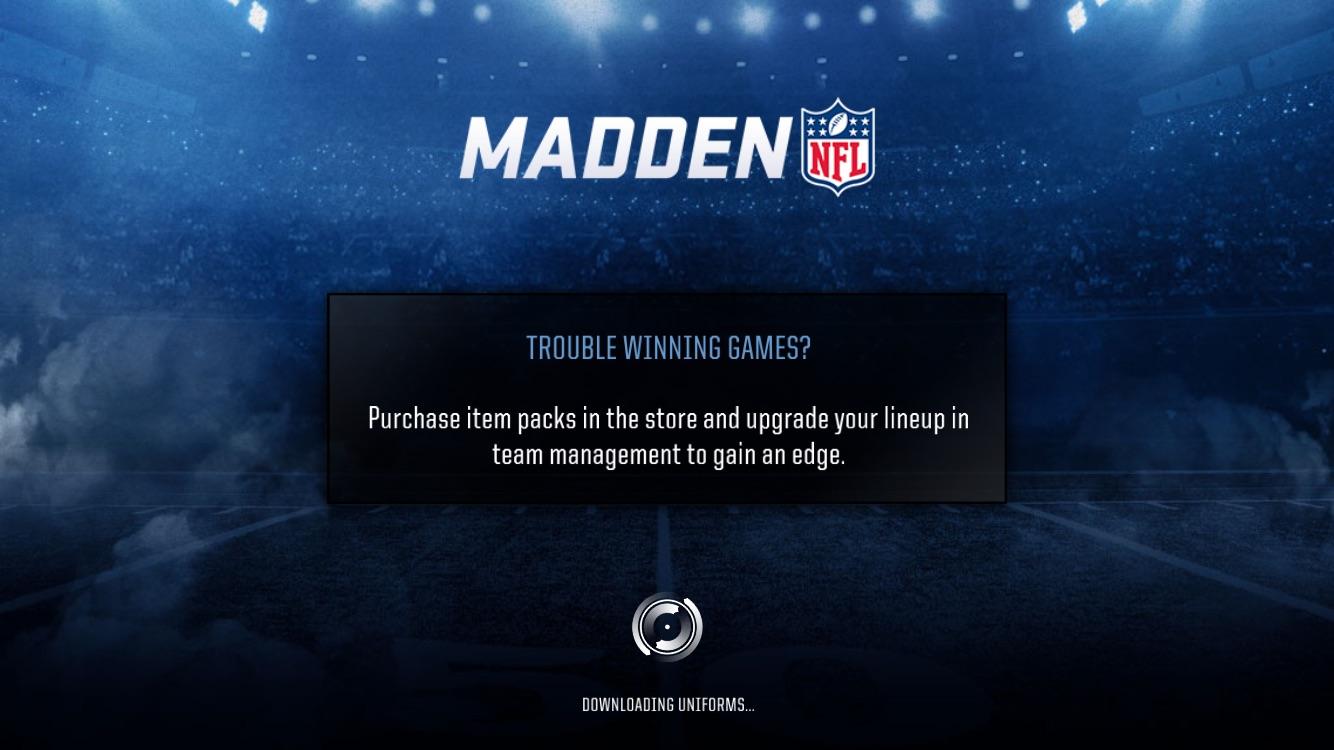
Thanks for the advice, EA (found on Reddit)
So back to Dungeon Keeper and Need for Speed. Both of these were once great franchises that EA destroyed by developing for the purposes of pushing lootboxes or their equivalent as opposed to compelling gameplay, but they had been doing this kind of thing for so long that I guess they felt they could do whatever they wanted. Speaking of which, it is important to note that EA is by no means the only company doing this – not by a long shot.
And then, Star Wars Battlefront II happened. I’ll bet EA never saw it coming, and from what I can tell they didn’t. I hope they didn’t, because their surprise and confusion over the backlash would make the whole thing that much better.
You see, EA decided that many of the characters and items in their new release of Battlefront II, itself a long-lived and beloved franchise, would be only attainable via lootboxes that contained random content, which may or may not be the ‘thing’ you as the player are looking for. If you didn’t want to grind away for who knows how long – Days? Weeks? – to get the stuff, you could pay real money instead. You could also buy lootboxes to get game-changing benefits that severely unbalance the game in your favor, and against everyone else’s: In one video I saw, a player paid real money and got the ability to lock on to targets 200 percent faster than others. The environments in that video really look nice, too, which makes the whole thing that much more troubling – it looks like there could be a good game in there.
Although there has always been backlash against this nonsense, what EA tried to do with Battlefront – remember, Battlefront is a long-running and revered franchise originally developed by Pandemic and published by Lucasfilm – unleashed the rage of countless gamers and has begun a snowball reaction that has even surprised us. First came the Reddit rage. Lots of rage comes from Reddit, but this was different: It was loud, and it was sustained. So severe was the response that EA backpedaled and made some changes, however they also stated they were not removing the lootboxes altogether.
Again, I think EA was blindsided by the response because this practice is nothing new to them. But never mind EA Spouse, or them having the most downvoted post in Reddit history, which itself was in response to a Reddit user who created a spreadsheet showing that unlocking high-level characters in Battlefront II would take about forty real hours, or even being named worst company in America two years in a row; what happened next is where this story really takes off.
The uproar was so loud that government agencies around the world started looking at whether the very concept of lootboxes should be considered gambling. The argument is, if you are paying real money in the hopes of getting something of value in return, then it should be classified as such. I am not taking a side on whether it can formally be defined as gambling, I’m just saying that designing games as revenue streams first and games second is a putrid, vile practice.
It seems some agree. Belgium is on the edge of classifying them as gambling (the linked article erroneously states they have, but they haven’t yet), Australia is also investigating as is France, while Denmark has said they don’t meet official gaming (read; gambling) criteria.
Here in the States, and what inspired this post in the first place, representative Chris Lee from Hawaii has taken it a step further and is not only considering lootboxes but the larger issue of predatory business practices in games. He is clearly a gamer himself, he even cited the standard, old-school business model mentioned above, and chimed in on a Reddit thread regarding the topic. He put out an initial video putting forth his opinions on the topic, and it became so popular that he then added a much more intimate, personal take on the controversy, which he intends to be an ongoing video blog covering his dealings with this issue and progress made. It was then that I knew this whole thing has taken on a life of its own. It is, I’m hoping, out of EA’s hands now, and about to be addressed on a much larger and more enforceable scale.
I’m hoping all this attention finally gets game companies back to making games. Not things that look and feel like games at a very low level while requiring the player to continue to buy to continue to play. I’ve been against it for a long time, even going so far as to say some ‘games’ aren’t games at all; they possess no elements of gameplay but want you to keep paying in order to see all the ‘game’ has to offer. One of the worst offenders, a ‘game’ I despise but everyone else loves is The Simpsons: Tapped Out. I love The Simpsons as a TV show, but with the app, what no one seems to realize is that there’s no freaking game! There’s a narrative, but that’s it. You don’t actually *do* anything. Tap on this character, they go into a building. Tap on that character, they deliver a line of dialogue then go in to a building. Tap the money floating above the buildings. If you can afford it, tap here to build a building (which builds over time, unless you pay to build it). Can’t afford it with in-game currency? Or want one of the items only available through a real-money transaction? You know what to do. There’s no skill involved, no character building; I suppose a minimal argument could be made for planning, although even that’s excpetionally limited, and storytelling, which is its strongest point, but there’s no game to go along with it. The Simpsons is not alone, considering in-app purchases are common, indeed rampant, in the mobile space, and even more insidiously they are often aimed directly at kids. That’s why things like this and this and this happen. Remember Joe Camel? He was banned too, for very similar reasons.
Fingers crossed. If I may invoke the names of one of my most beloved franchises that was also ruined (you can imagine by whom), I’d like to think maybe we can get back to making games that are more like Dead Space 1 and 2, and less like Dead Space 3. Wait, what happened to the company that made those first two masterpieces? Oh, that’s right. EA happened. And the second paragraph in the linked article is why we’re where we are right now. Here’s hoping for deliverance from what EA wrought.
UPDATE: Look what I found about three hours after writing this post! US lawmaker who called out Star Wars Battlefront 2 lays out plans for anti-loot box law.
Converting vintage toys into their modern tech equivalents
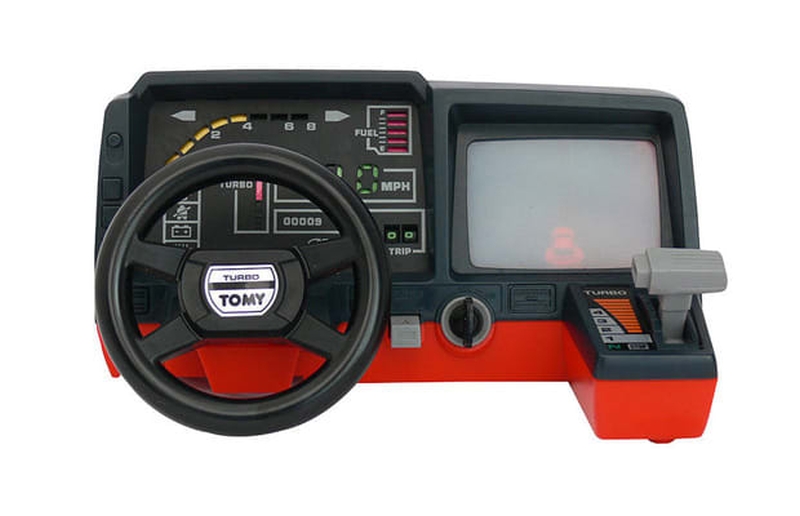
I’m not comfortable referring to toys I played with as a kid as vintage, but they are, and what this person does with them is quite inventive. His Nom de Plume is Circuitbeard, and among other things, he converts vintage toys into modern ones, while modifying as little of the original item as possible.
The one that prompted me to write this post is his updating of a classic mechanical driving game – in this case a Tomy Turnin’ Turbo Dashboard game – to instead be a fully functioning, self-contained, OutRun arcade game.
Before we get to that, the original Tomy game was quite an accomplishment in itself. Released around 1983, everything about it was mechanical, from the revs to the fuel gauge to the fake-but-passable digital speedometer. The driving is secondary, really, since there isn’t much to it other than keeping the car in the center of the road via your manual steering and not veering to the side nor crash into the exact same car that kept appearing since the road is really just a looping image. Even if you did, nothing much happened, and remember this isn’t a video game, it’s all mechanical.
It’s a hard thing to explain, so here’s a video that shows how the original looked:
The electronic magician Circuitbeard, on the other hand, took this device and turned it into the game it always wanted to be. Just like Pinnochio always wanting to be a real boy, this game always wanted to play OutRun. The details of how he did it, which are long and impressive, including custom printed PCBs, a custom, laser-cut dashboard, and LEDs that actually represent what’s going on in the game, can be read over at his blog post and I very strongly encourage you to do so. Not simply to experience the monumental creative and technical feat he accomplished, but to see the other vintage toys he has converted. It’s all very masterful, and fascinating.
I’m sure what everyone wants to know is how did it turn out (but don’t skip the details. Seriously!). Here is the video of the final result, and to add to the above paragraph it involved some custom libraries, bespoke 3D-printed parts, multiple controllers; it is not hyperbole to say it may be one of the most brilliant electronics projects I’ve ever seen. He has others, by the way, which are equally as magnificent.
Here’s the video of the final result, and don’t be deceived into thinking this was a simple project. Read his post!
Private WoW server Felmyst shut down in one day

There is, perhaps, a not-so-unknown secret in the World of Warcraft community that many people are unhappy with the way the game has evolved. Streamlined interactions, fast travel, the loss of talent trees, major changes to the landscape (such as the now-flooded Thousand Needles), rapid leveling, repetitious quests, questionable lore addons, and so on. It is also relatively well known that because of the longing some players have for the much more involved, grindier, slower-paced, talent-centric nature of the original WoW, private servers, meaning ones not run by WoW developer Blizzard, have popped up all over the place.
One of the best and most stable of these private servers was Felmyst, a four-year labor of love by a developer known as Gummy, who suffers from Musular Dystrophy and is for all intents and purposes, homebound. Well known in the private server community, both Gummy and Felmyst were doing well, with a stable build and a solid user base. However, a mere one day after the Felmyst servers finally went live, Gummy received a Cease and Desist order from Blizzard. You can read the gory details over at Ars Technica, and I should also mention that I was going to post Gummy’s formal announcement about the shutdown that he posted to his website, however the website went offline just one day after he posted that. For a four year project, it vanished into thin air very quickly.
UPDATE: Apparently his response is back up on felmyst.com, but for how much longer I can’t say. Here it is:
If you’re the lazy type who doesn’t like to click on images, here is what he wrote:
Felmyst
I began this project roughly four years ago and last year when Blizzard began taking action more seriously it weighed heavily on me as not only was I already heavily invested into the work but others around me were as well. Because of my health situation I wasn’t in a position to cut losses and start over on something different, at least not something that would take four years to make. Last year’s news of what Blizzard was doing came at the absolute worst time for me, frankly, with so many years already invested. To explain what may appear as an odd series of decisions it seems worthwhile to disclose my condition, muscular dystrophy, which only one other person in the online sphere knew of until now.
Of course, that is why I’m not able to pick up and move to another country as an alternative means to host the server since I’m not really able to live on my own. That is also the reason I’ve been able to work mostly full time on this project as I’m unemployed, though I have sacrificed much of my well being dedicating everything I have to this. Why am I disclosing this? I’m not really sure, but I feel compelled to.
So the question instead becomes: why host it yourself? The problem with that is our popularity snowballed way too fast once the release date was set.
Before the release date was declared, most people expected the server to flounder with a small population, the irony of which quickly became a meme. Therefore, months ago I saw no reason to hand all of our work over to someone I didn’t know when the project had a reasonable chance to stay small enough to avoid the need. Though I have no problem contributing to honest developers, the market to wrongfully profit from this stuff is much too lucrative to hand it out on a whim. Had we time to smooth out the release, this certainly would have been something to explore. The warning signs to expect notice from Blizzard were there but receiving it that quickly was something I don’t think many expected.
So why did I make this project? I love the game and community, especially the community. The old game was a great way to meet people and see new faces. It makes me happy, and programming makes me happy. Of course, I am sad that things didn’t turn out the way I’d hoped but I don’t think I’d change any of the decisions I made. I gambled that we could cap the servers at 3k and enjoy a close community. Sadly, I did not win that gamble, though on some level it was nice to see so many people eager to enjoy something I worked on. This project gave the last four years of my life a sense of purpose that I thoroughly enjoyed.
So why not tell people of that plan ahead of time to stifle hype? The problem with private servers is that there is no middle ground. If people expect a server to “only” have 3000 (real) players then they just won’t play and you’ll instead end up with 300, which isn’t playable.
A lot of people are of course asking for the source code. Although it may not be in my best interest to distribute the whole thing in its entirety at this point, I’ll see what I can manage that would be beneficial to other programmers who are still learning.
Gummy
gummy52facebook@gmail.com
All of this rubs me the wrong way. The fact that the C&D order was delivered just one day after the servers went live even though Blizzard must have known about it years ago, that the servers went down so fast, that the website went offline so fast (but is now back), it was just scrubbed into nothing immediately after such a long development cycle. Maybe Gummy simply was spooked by having a multi-billion dollar company com after him. Some in the community said he should move his servers to another country to circumvent Blizzard’s attempt at shutting him down, however Gummy claims he doesn’t have the resources for that. Others were and are still imploring him to release the source code, however he states there are legal implications and ramifications to doing that and has therefore made no such commitment.
Another interesting legal wrinkle is that it is apparently not illegal to run a private server, the issue is distributing the client along with it that causes the problem. I don’t know the technicalities, but there has even been the argument that if you kept the servers up without including a client, which the Felmyst download did, there wouldn’t have been a problem. Again, I don’t know the specifics of the case and Blizzard’s claim to IP so I can’t comment on that. I can say that Gummy claims to have done most of the coding to get the thing up and running.
Frankly, I don’t know what Blizzard’s obsession is over not setting up a vanilla server themselves. They shut down Nostalrius, claiming the whole time they would work with the team to set up an officially-sanctioned legacy server, then just…nothing. Frankly, Blizzard lied to them, to us, and did so deliberately. On Nostalrius’ official site, you can read the latest announcement, from all the way back in May of 2016 – and note there has been nothing since – of how Nostalrius thought they would be part of something great and working with Blizzard to set up a legitimate vanilla server, not realizing they were being misled. To show how big the demand is for something like this, which incidentally would cost Blizzard very little to implement, this is a no joke screenshot from the last minutes of Nostalrius:
Seems like something people want.
So what can you do now if you wish to play the informally-labeled ‘vanilla WoW?’ You can do what I did, and switch over to Elysium. You have to get the client via torrent, but it’s stable, works beautifully, and for someone like me who still remembers being blown away when they first saw WoW, and longs for the difficult, slow, plodding, yet rewarding gameplay experience original WoW offered, it’s glorious going back to those early days; before Thousand Needles was flooded, before Durotar was as well, before the great sundering, before all of that. When Barrens Chat was as lively as ever, the Defias roamed free, you had to train skills, and find Mankrik’s wife, when some wore a Big Blue Dress and Alterac Valley could go on for days, when you had to suffer abysmal drop rates to earn your levels in order to pay 40 gold for a horse, it brought a tear of joy to my eye to relive those opening cinematics for the Undead and Tauren that hooked me right from the beginning. Its default graphics settings made the game look like I was back in its 2004 release date, but after cranking everything to max, the game looked beautiful.
Additionally, I set up characters on their Anathema server, which was recommended to me, however their Elysium server is much more populated. That’s good on the one hand as the opportunity for groups and simply interaction is higher, but it comes at the expense of gameplay as it can lag severely, although I suppose that is quite reminiscent of original WoW. On the Anathema server, things are better, but it is still well populated, runs smooth, and I personally feel has a better balance, plus I still get to experience groups, Barrens chat, and and interaction. Here is a pic from Orgrimmar on Anathema, and as you can see it’s bustling with activity.
There’s even whisper spam from gold farmers!
The only real problem I had was naming my character. Every single name I typed in gave a ‘That name is unavailable” error, even some of the ones it recommended to me did the same! There were some other minor, non-gameplay related things: At one point I repeatedly took fire damage although I wasn’t near a fire, an NPC referred to me by the wrong name, and an NPC clipping through the world; he came back though. There is also only one server, so server time never lines up with actual time. Other than that, no troubles so far.
Well, except for this:
UPDATE: Recently there have been some major server crashes. Actually, I don’t know what the specific issue is, but today all action stopped, and never started again. I wasn’t kicked back to the character select or login screen, it didn’t freeze up, it just stopped responding. My character could run around, but that’s all. All other players in the vicinity vanished. It also was unable to login to the character select screen afterwards, and had to x-out (I play in window mode) to try again. This happened multiple times today, my third day in. It has been smooth until now, and a patch was just rolled out earlier, which may have something to do with it.
UPDATE II: The issue was fixed, however I lost about 40 minutes of progress.
As great as it all is, be warned: it is not for the faint of heart. It is the grindiest grind in grindville, however because it is (I think) Burning Crusade, you level up a little faster than pure vanilla. But it is also very unforgiving ear;y on for some classes. For a while, as a Tauren hunter, around level 8 I was dying more than I was questing. I spent a lot of time in black and white (meaning dead), and I would get stomped by same-level mobs. For every one I killed, I would be the loser multiple times. Enemies are densely packed, it’s very easy to draw multiple aggros, and you often have to proceed very carefully. Once I got a pet, however, the whole dynamic changed and it became much more balanced. In the brief time I spent with some other classes, rogues, druids and warlocks made it much easier to progress early on. Warriors and priests, not so much. I didn’t try the mage or shaman classes.
It’s been very fun returning to almost-original WoW. When it was first being hyped all the way back in 2004, I didn’t pay it much attention, reading about it in game magazines with only passing interest. When the beta rolled around I thought “What the hell, I’ll give it a whirl” and was floored by what I saw. Immediately hooked, I knew I was witnessing something, experiencing something monumental; both literally and figuratively game-changing.
In fact, I got so much out of original WoW, had so many good experiences (I’ll never forget a higher-level Alliance chasing me all the way from Thousand Needles to Un’Goro crater, where I jumped over the edge and slowfell to the ground below, escaping my pursuer, only to be immediately devoured by a dinosaur. Good times.), I actually bought the Bloodscalp server on which I used to play when Blizzard auctioned it. It’s a prized possession.
I never played Alliance because they’re the dirty, stinking Alliance.
So if you have never experienced original WoW, if you are a latecomer, if you want to know what all the fuss is about, if you wax nostalgic for the more pure version of the game, then I encourage you to try out a vanilla server and see what you think.
I’ll update as I continue on. In the meantime, here are the original intros for the Human, Tauren, and Undead races, all recorded at max settings off Elysium’s Anathema server. I also included a very brief bit of running around to give an idea how it looks.
A Successful Game Development Class

AUTHOR’S NOTE: Because many of the groups mentioned in this article may continue development of the games mentioned and with respect to their work and designs, I am limited in what I can show of many of them.
This quarter, I was asked to take over our department’s ‘Computer Game Development’ class from another faculty who was retiring. I guess it had something to do with that donation I made, but I was happy to do it, the retiring faculty recommended me personally, and offered all his materials for my use and adoption.
With absolutely no disrespect meant to him at all, I learned subsequently that he wasn’t actually a gamer, he was a programmer who developed this course as more of a technical overview of some coding techniques that could be applied to games, such as client-side prediction and some GPU tricks. Ultimately, much of the class was given over to project development time as opposed to formal instruction, as is common in a project class.
I decided to take the class in a different direction. We did talk about those things and other technical issues (and Thursdays were scheduled as project times as had been done before me), however as I always tell all my students, ‘you can’t develop technology in a vacuum.’ Or in this case, games. In other words, there is so much more to developing games than writing code and using unity. There are artists, musicians, writers (I made a HUGE deal about writing for games), level designers, and on top pf that, as my students also know, an understanding of how the industry and games themselves evolved is important; that context helps inform your decisions today.
So we talked about history, we talked about writing, we talked about level design, we talked about morals and ethics, we talked about the engines available today as opposed to the assembly languages available back when, we talked about character design and plot progression and player investment and balance and honing. All the while, students developed their own projects.
It is still a project-based course, as it was before I came along. Students are expected to develop a game using any platform and approach they wish, as long as it showed technical prowess and creativity in design. It is expected that students in this class have a background in Python and Java at least, although most have solid C# backgrounds as well.
My main directive to the groups was “Don’t build an ashtray.” I tell that to a lot of my project classes. You see, when I was in high school, I took a woodshop class, and the teacher – Mr. Cagle – went around the room asking each student what they would like to build that session. The responses were thoughtful; one kid wanted to build a full archery bow, another a roll top desk, and yet another a soap-box racer kind of thing. However one kid, when asked, said with his head down “I don’t know, I’ll build an ashtray.”
An ashtray? AN ASHTRAY? Everyone in the class had these great ideas, ones they had thought about and developed, but this guy who I guess didn’t care or wasn’t interested or wasn’t motivated or perhaps just lacked the fluid thought necessary could only come up with an ashtray, a single-component item that could be made out of clay in about two minutes. He had an opportunity to create something really interesting and unique and that’s all the better he could, or was willing, to do.
I always remembered that kid, and so even now I tell my project groups to not be that kid, don’t build an ashtray. In other words, be creative, be unique take this opportunity to explore your ideas and test your abilities.
They did not let me down.
One group developed a game about someone suffering from Irritable Bowel Syndrome, and the entire game had a timer that counted down continuously until a bathroom was found, which only served to reset the timer.
Another group developed a platform game in which the player had to switch back and forth between light and dark worlds in order to traverse levels. Another involved a pirate with a hook hand swinging through levels to gather gold and still another group created a game in which two brothers navigated through their own individual levels, with the effects of what one brother did (stopping time or causing rain) manifesting at the same time in the other brother’s level. And there was also one that was pseudo-text based and emulated a greenscreen of yore, with the player using actual Linux commands to solve some of the puzzles and minigames.
There was also a mobile game about a dog fending off a flea attack, Harambe escaping his captors, some flashlight-based games, a dungeon crawl, an RPG with unconventional characters, a ghost coming to terms with his infamous past, and a fantastic card game in which you navigated a 3D town and the group designed all the card graphics using a stained-glass aesthetic which was understated yet beautiful.
It was also required that teams develop websites and promotional materials for their games, and even many of those were outstanding. Some allowed for the downloading of demos and other materials, while others were more informational.
One group, pictured in the header and below, developed a party game so complete and well-polished that I felt, and from what I heard others did as well, that with just a little more work it could go up on Steam or the Xbox/PS stores. Because of that, the name of the game had to be blurred out.
At the end of the quarter we held a showcase that was open to the public, and in which every team was able to show off their creation. It was a great success, especially considering all 121 students, 21 teams, were crammed into the same moderately sized conference room. It was hot in there!
A couple of the games are playable online, so I’ll link to those here:
CoinUp, a game in which two players remove coins from either end of a row, with the goal being to have more money at the end of the session. It can be played as one game, best of three, or best of five, and the powerups add a tense twist to the action. It’s a simple game that can be frustrating in a just-one-more kind of way. EDIT: No longer online, I’ll see about the executable.
Another is Quadris, which is a Tetris clone in which gameplay takes place in each of the four compass points, and has you constantly switching perspective. It’s hard to explain but a blast to play. You can play it here.
I’m very proud of all of them; despite the nature of the course it’s very stressful as they only have 10 weeks to design and develop their game. Regardless, they all came though magnificently, and while I certainly learned that some structural changes will have to be made for next time, I’m already looking forward to what the next class is able to create.
I have finally hit the big time (potentially NSFW, but not really)

Has it really been a month since my last post? How time flies when you’re insanely busy and out of town for a week on top of that. My apologies, but I assure you, this post will have been worth the wait.
I know that headline can be interpreted several different ways and may lead to some raised eyebrows, however it’s not as risque as it sounds. I’m not even sure the ‘NSFW’ tag is necessary, but better safe than sorry I suppose. About a month ago – and I meant to post this earlier but just couldn’t find the time – I was the featured expert in an article in Playboy magazine about the evolution of vibrating game controllers titled ‘The Bizarre History of Vibrating Controllers: VR Precursors, Occasional Sex Toys.’
I’m featured pretty prominently in the piece, and it really is a well-researched and relatively complete examination of the topic, however it is Playboy, and as you can probably tell from the link title the article veers into the, well, it veers into what you’d expect a Playboy article to veer into, even though the magazine no longer features women in birthday suits.
But I recommend it. If you don’t mind some very mild prurient evaluation, meaning absolutely nothing even close to x-rated but briefly talking about the adult potential of such controllers towards the end, it’s an informative read and respectful of its topic.

